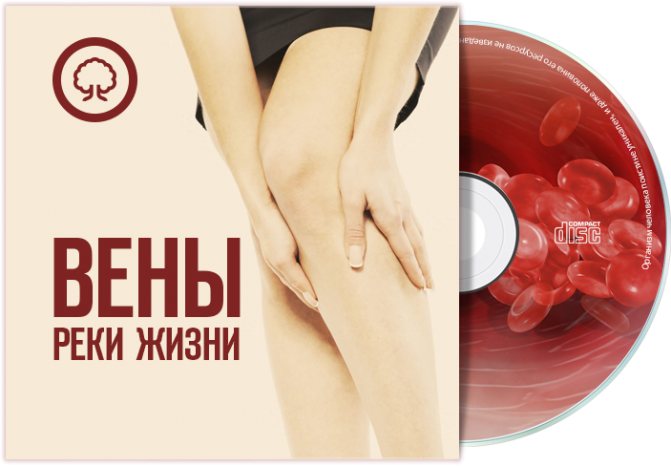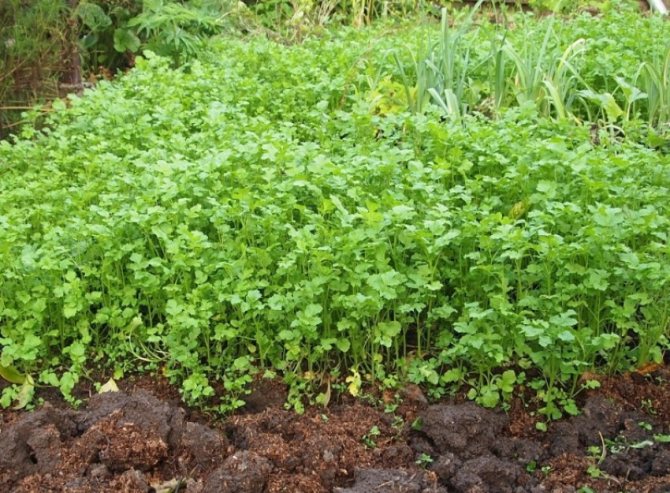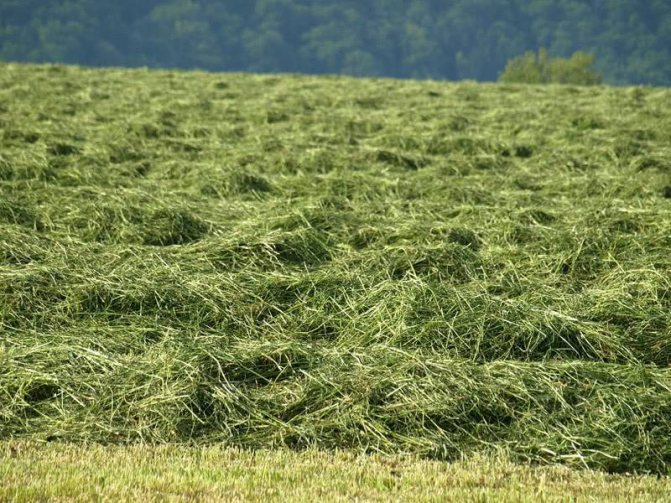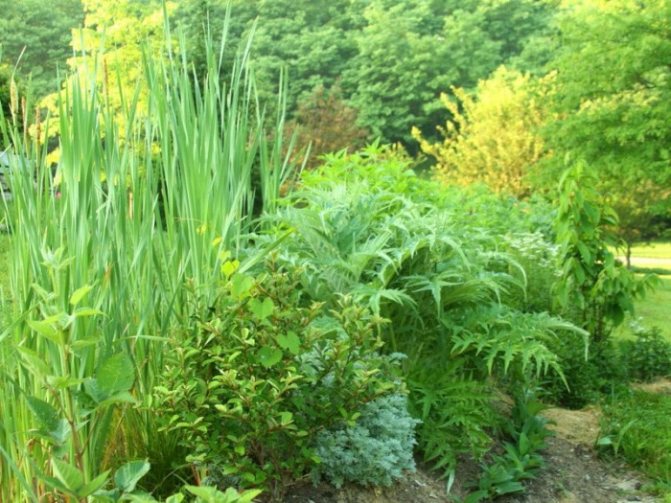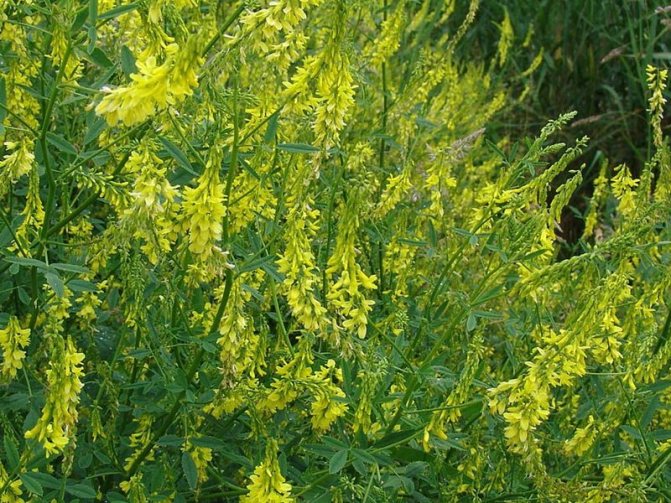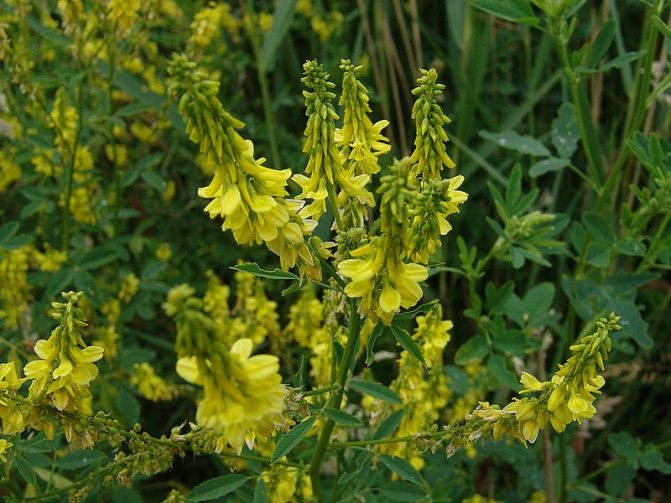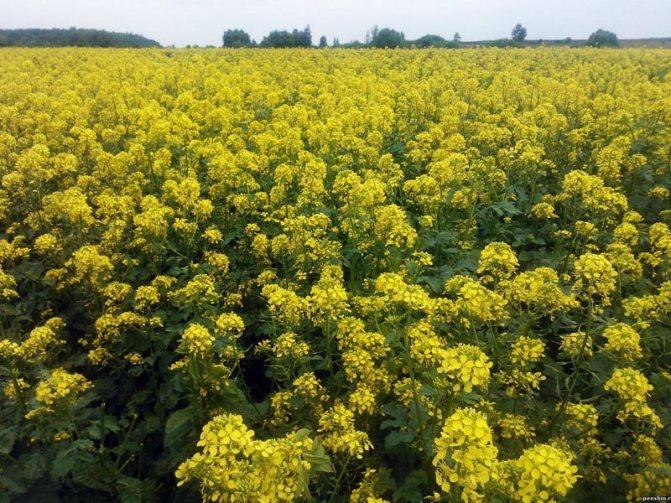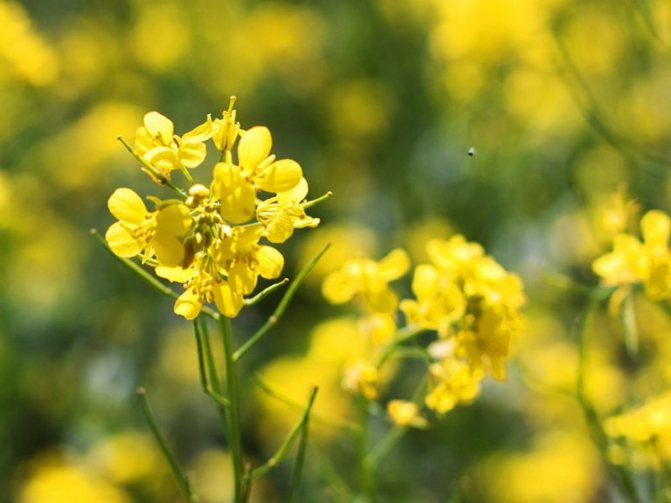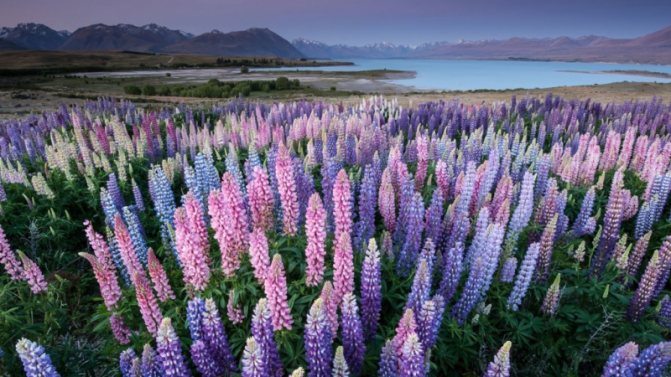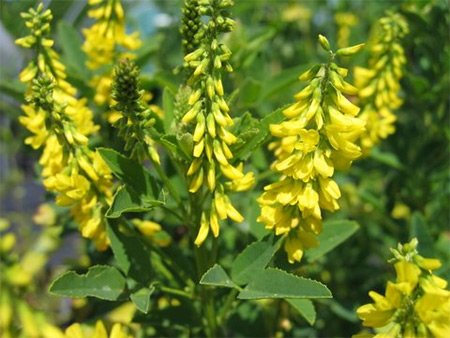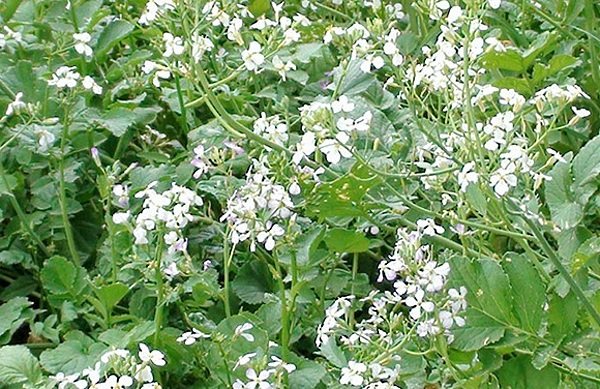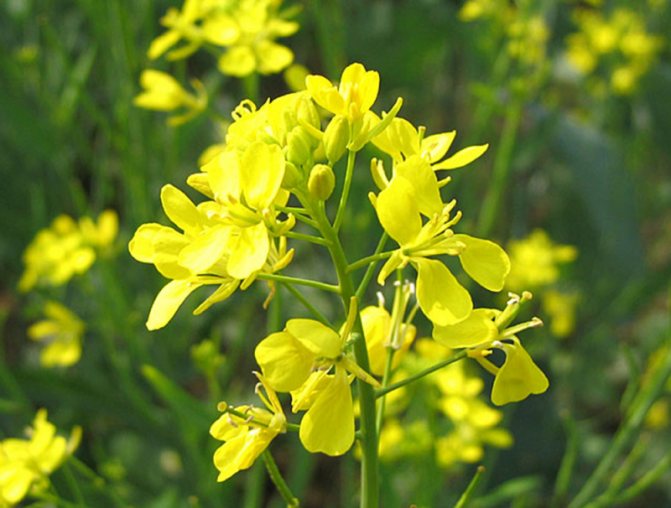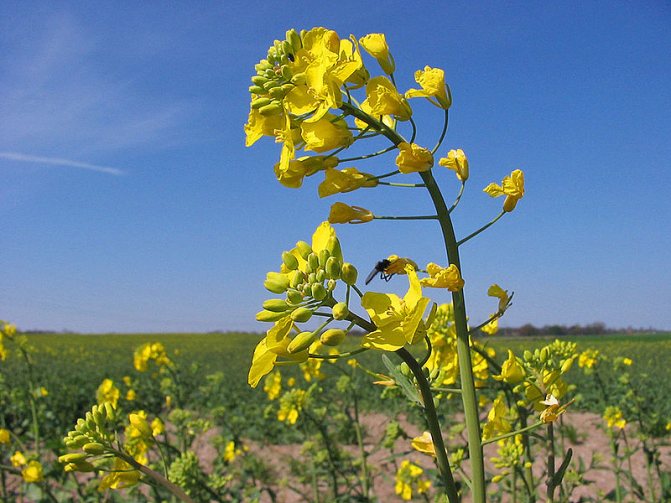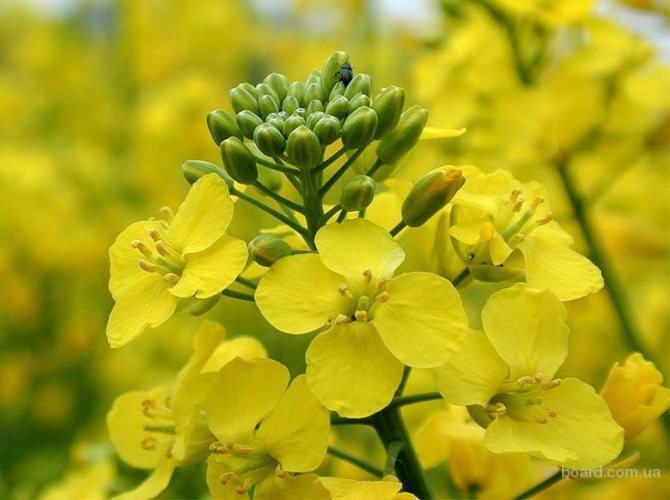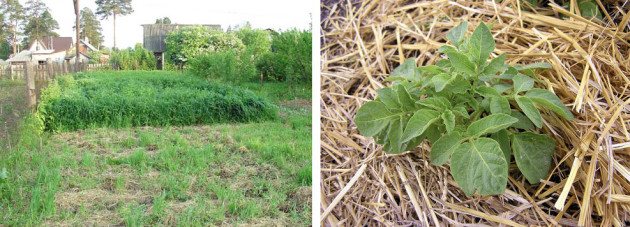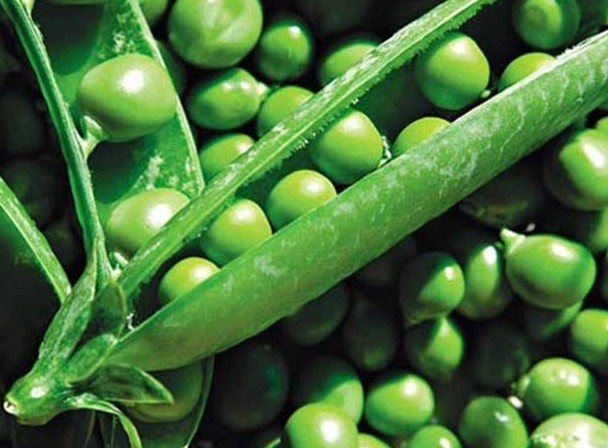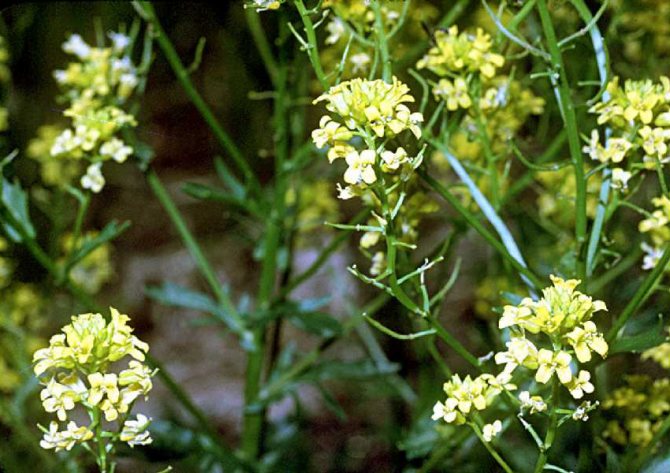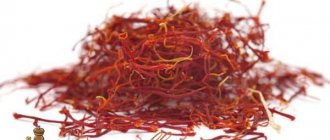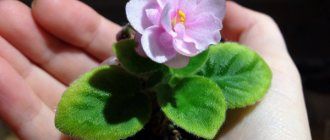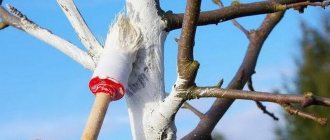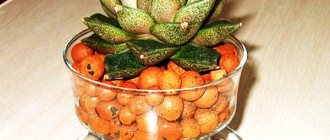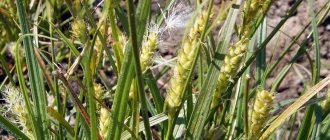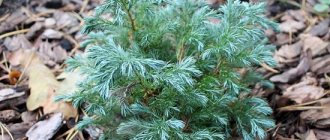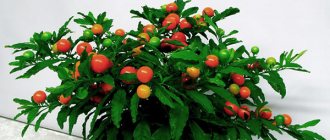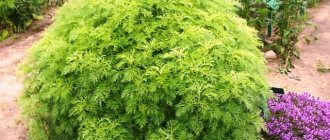
To use mulch from green manure plants, and the more nutritious, varied and “tastier” it will be, the better it will be for us in the end - aren't ripe bunches and a ripe vine a worthy reward for mulching grapes?
Let's remember that fertilization is a process that increases the ability of the soil to bear fruit.
And this means not only (and not even so much) an increase in the content of nitrogen, phosphorus and potassium in it, but also organic matter, which ensures the activity of soil microflora and the supply of carbon to plants.
What are siderates and what are they for: the main features of cultures
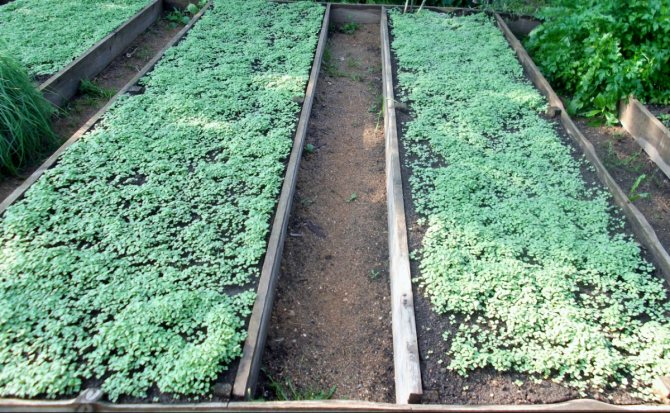

Different types of green manure plants are grown for different purposes: soil disinfection, protection from pests and diseases, increasing fertility and obtaining mulch. Siderata are sown in a free plot of a vegetable garden or in a garden bed with other crops. Then the overgrown green part, without digging, is cut off and embedded in the ground. This enriches the soil with nitrogen, prevents the growth of weeds and the spread of bacterial and fungal diseases. In terms of efficiency, such plants are comparable to manure.
What is the advantage of siderates?
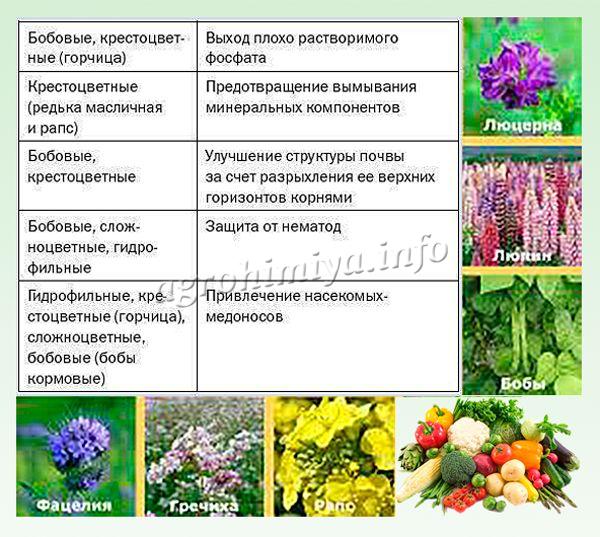

The main advantages of green manure
Many gardeners do not use green manure, as they are afraid that these crops will simply litter the garden. But in reality this is not the case. The fact is that such plants need a very long time to ripen and give seeds - they simply do not have time to do this - they harvest them long before the seeds appear, namely when they begin to bloom. What are the main advantages of green manure?
- Can be excellent wind protection. They are often sown to protect certain garden crops from strong northerly winds.
- Enrich the upper and lower soil layers with useful substances - increase the percentage of biomass.
- Retain moisture.
- Loosens the soil and prevents erosion.
- Retains the growth of weeds. Thanks to siderates, you can generally forget about weeds - it will be very difficult for them to break through the dense thickets of fertilizer herbs to the sun.
- Some green manures can repel pests and even prevent the development of diseases. So, for example, mustard is recommended for scab, and radish for nematodes. Other green manures simply distract pests from garden crops.
Sowing dates of such plants
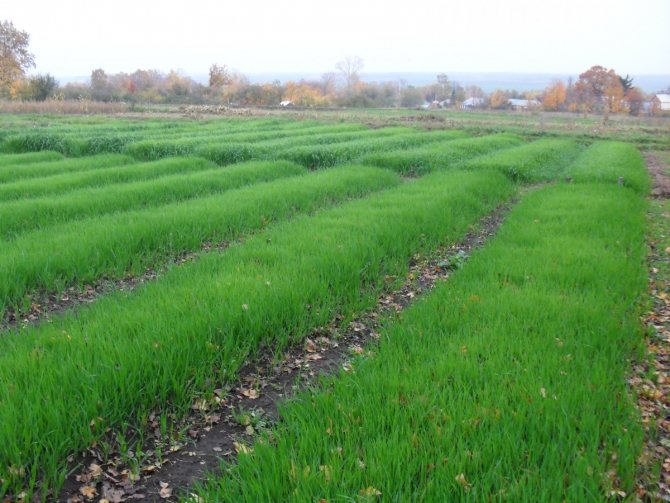

Siderata can be sown throughout the year. During this time, some summer residents receive from three to four harvests of such fertilizer, because their growing season is short.
Spring
In the spring, the green part of the green manure grows rather quickly and does not allow the weeds to actively germinate. Then experienced gardeners dig up the entire area with green manure contained in the ground, and only then plant the main vegetable crop. The earliest green manures for sowing are sweet clover, seradella, radish, oats, mustard, phacelia, peas, vetch, alfalfa.
Summer autumn
During this period, green manures are sown only after harvesting the main crop. This is done to restore soil fertility. At the same time, the plants are regularly mown until the budding period, and after that they are not removed, leaving them in the beds. In summer and autumn, legumes, phacelia, buckwheat, rapeseed, and mustard are sown.
Before winter
At the end of the gardening season, winter cereal siderates are sown densely, including in mixtures. In this case, the crops are no longer mowed so that the soil does not freeze in the cold. In the spring, winter green manures are plowed into the ground before planting as the basis of the crop. Do not overdo it with the number of plants so that the soil does not acidify. The surface is mowed and stays on the ground as mulch. Mustard, radish and rapeseed are also used for winter sowing.
How to plant correctly?
How to sow green manure in the garden? You can plant them yourself as a compact or catch crop. Rows, stripes (wings) or scatter.
General landing rules:
- Loose, moist soil.
- Easy "pressing" of seeds to the ground.
- Savings from birds.
- Green manure and the main crop after it should be different by family.
Green manure plants in the garden can be raked with a rake, planted on any vacant beds. There should not be a lot of compacting culture, otherwise it will oppress the main plantings.
Correctly planted and timely cut green fertilizers heal the earth in a natural way, not yielding to compost in nutritional value, and destroy pests. At the same time, green manure garden plants are much cheaper than chemical preparations, do not leave harmful consequences for the soil and basic vegetable crops.
Common types of green manure crops
About 400 plant species are used as green manure. The choice of this or that type depends on the quality of the soil and on the main type of vegetables grown. The most popular green manure crops are:
- legumes - peas, soybeans, broad beans, lupine, alfalfa, seradella, sweet clover, sainfoin, beans, clover, spring vetch, chickpeas;
- cereals - winter rye and wheat, millet, sorghum, spring barley and oats, mixtures (timothy, ryegrass, fescue);
- cruciferous - rape, rapeseed, mustard, oil radish;
- hydrophilic - phacelia;
- buckwheat - buckwheat;
- aster - marigolds, sunflower;
- amaranth - width, amaranth.
When choosing a culture, the following main rules are adhered to:
- green manure and main crop should not belong to the same family;
- for greater efficiency, green manures are cut at the stage of budding or active flowering, but not later;
- the selection of plant fertilizer depends on the composition of the soil, for example, cereal plants are best suited to clay soil.
The most popular cultures among summer residents and gardeners are mustard, phacelia and sweet clover.
Mustard
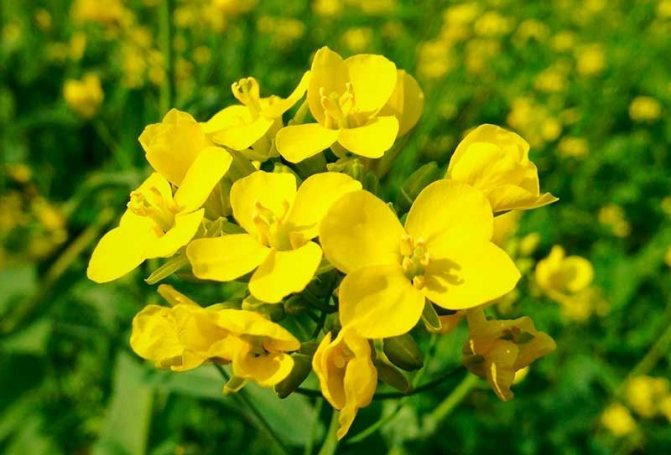

Annual with whole leaves and flowers of pale yellow color, collected in inflorescences and smoothed whole leaves. Grows up to a meter in height. White mustard is used for green manure. Sowed with potatoes, beans, grapes and fruit trees. Mustard enriches the soil with nitrogen, phosphorus and trace elements. Promotes the rapid growth of crops and protects them from pests.
After using mustard as a fertilizer, do not plant radishes, radishes, cabbage, lettuce and other cruciferous plants.
Phacelia


Phacelia is a member of the aquifolia family. Bell-shaped phacelia is used as a fertilizer. It is an annual plant up to 24 cm long, with compact blue or lilac flowers that form inflorescences in the form of a brush and resemble miniature bells.
Phacelia is a versatile green manure suitable for all types of vegetable crops. Enriches the soil with potassium and nitrogen, neutralizes soil acidity, prevents weeds from germinating. Phacelia roots, located superficially immediately after mowing, rot, forming an air-permeable protective layer. Grows in peat, chernozem, clay and loamy soils, not afraid of frost.
Donnik
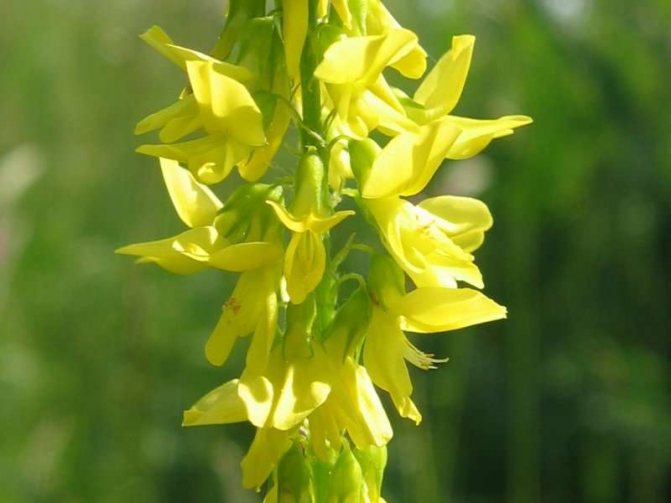

Perennial, the height of which varies from 50 cm to 2 meters.It has a branched stem, taproot, trifoliate leaves. The flowers are long, drooping, white or yellow. The plant tolerates frost and drought well. Grows on clay and sandy soils.
Melilot accumulates nitrogen in the ground and improves the structure of the soil. The mown green mass improves the activity of beneficial microorganisms in the soil, protects plants from such pests as wireworms and nematodes, and the aroma of flowering melilot attracts pollinating insects. Suitable for fertilizing all types of vegetable crops.
Green manure is an excellent alternative to chemical fertilizers that have a destructive effect on the soil structure. In addition, the seeds of these plants can be purchased at an affordable price. That is why green manure crops are very popular among summer residents.
Benefits for the vegetable garden
Modern green manures for the garden are plants that quickly go into the green mass, which is mowed to leave on the surface of the soil, while the roots remaining in the ground, rotting, serve to enrich it. Planting in the spring between fruit trees increases the palatability of their harvest and resistance to cold weather. In summer, green flowering plantings actively attract pollinating insects.
Restoration of soil fertility
Green manures are planted in the garden to restore soil fertility. Green fertilizers act on garden lands like real "living water". What is needed for soil fertility? Neutral acidity, natural nutrients, sufficient air and micro-habitat activity. The rest of the conditions will be created by a person by his departure.
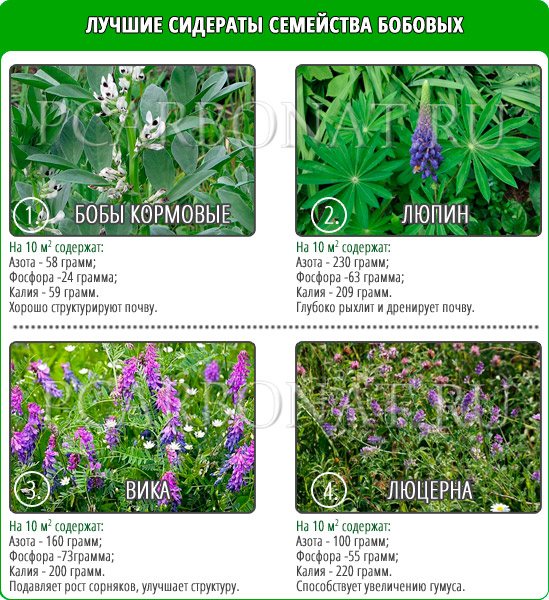

Green manure plants give the best nutrients for the upper layers of the garden soil, "extracted" from the very depths, to which their roots could reach. But their benefits do not end there either. Planting really "revives" the soil of the garden, turning clay strata into fertile, and not allowing sandstones to disintegrate. A lot of "work" is being done.
- Heavy soils gain airiness by loosening them with plant roots.
- In the garden, green manure plants deoxidize the soil, improve its permeability to moisture, and protect it from overheating.
- They carry nutrients along the ground in a form familiar to microscopic organisms. Decomposing, they turn into organic matter.
- Worms, attracted by the enriched soil, additionally loosen it and saturate it with carbon dioxide, which is important for plants.
To restore soil from erosion and preserve the top fertile layer in the garden, green manures are the best plants.
Green fertilizers have a special "relationship" with seedlings of various crops. The sprouts in the garden quickly grow stronger, since they are well protected from the cold, scorching sun and wind. Just a few days - and the greens of the green manure will be cut for mulching the seedling ridges.
Protection against plant diseases and pests
The best green manure plants for the garden are real "orderlies".
- Nematodes and locusts are killed by phacelia or oil radish.
- The wireworm does not like phacelia, mustard, rye.
- The Colorado potato beetle is afraid of the perennial lupine.
- All soil pests do not like mustard.
Siderates, "friendly" with pests or spreading diseases, do not exist.
Whether gardeners plant siderates for the winter or another season, planting will always benefit the soil cover and follower plants, keep them from pests, cold weather and diseases.
Influence of green manure on soil structure and their application
To improve the structure of the soil, organic and mineral fertilizers are used, peat, sand or clay are applied. Some of these processes are laborious, mineral fertilizers clog the soil.
There is another way to improve the soil: the use of green manure. It has been known for a long time, but has not yet become widespread. Siderata are fertilizers that grow directly in the place where they will be applied.The name comes from the term sidera, which translated from Latin means "receiving strength from the sky."
Siderata are plants that can enrich the soil and improve its structure. They are sown in front of the main crop, wait for germination, allow to grow, and then mow and plow into the ground or leave to lie on the ground. The main plants can then be planted.
Siderata perform several functions:
- They make the soil less dense.
- The plowed shoots and roots of legumes enrich the soil with nitrogen and other nutrients.
- High dense plantings protect the soil from drying out.
- Siderata suppress the growth of the weed root system, inhibiting it and slowing down its development.
- The roots loosen the soil well.
- After the roots die off and decompose, green fertilizers, humus are formed in their place, these areas are well filled with air, and during rain - with water. It lingers longer in the upper layers of the soil.
Followers of non-moldboard tillage claim that plowing and digging the soil destroys beneficial microorganisms. They advise leaving the cut pieces on the site and covering them with mulch. This is especially true for winter crops. Shoots during this period in the garden do not bother anyone, they quickly rot, releasing nitrogen and loosening the soil. The fertilizer comes out environmentally friendly.
Leguminous plants are used as siderates, which grow rapidly and gain weight. They have the ability to kill pathogens and disinfect the soil.
The best green manure legumes:
| Name | Features of the | Photo |
| Lupine | Enriches the earth with nitrogen. Introduced in early spring or after potatoes and cabbage |
|
| Donnik | Sown in early spring, summer or fall |
|
| Vika | Sown in September. Good precursor for seedlings | |
| Alfalfa | Replenishes the soil with a complex of trace elements |
| Name | Features of the | Photo |
| Oil radish | Fights nematodes, binds nitrogen. Planted together with vetch |
|
| Mustard white | Contains organic acids that dissolve phosphates, enriches the soil with potassium |
|
| Rarepitsa | Improves soil structure. Sowed in August before winter crops, corn, potatoes |
|
| Rape | Kills pathogenic bacteria, enriches the soil with sulfur and phosphorus |
|
Among cereals, winter rye is more common as green manure.
Buckwheat is used, which grows quickly and has a long (up to 1.5 m) root system. It supplies the soil with phosphorus, potassium.
- calendula contains many useful substances;
- sunflower produces a lot of greenery and grows in any soil.
Siderat amaranth is prized for its fast growing.
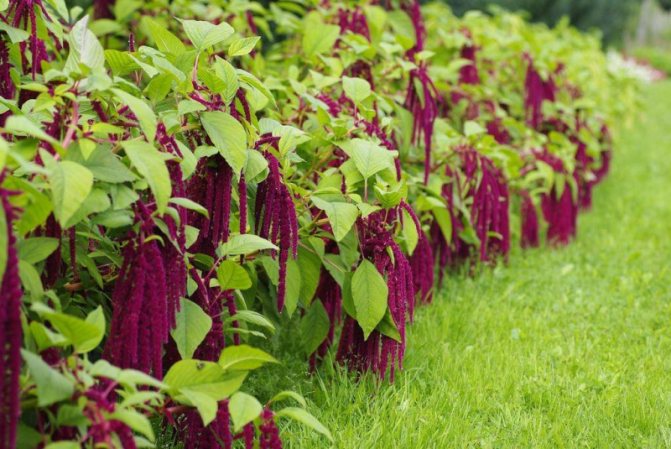

Phacelia tansy is an annual plant that belongs to the Aquifolia family. Reaches a height of 1 meter. Bunches of small fragrant flowers bloom on two dozen lateral shoots. The plant is a good honey plant, attracting bees for about 2 weeks. Has a number of advantages:
- Phacelia can be sown early, immediately after the snow melts. Seeds in the soil can withstand temperatures as low as -8 ° C, and seedlings do not die at 3 degrees. Therefore, it can be grown even in Siberia.
- It tolerates drought well, does not require watering.
- Transfers light shade, making it suitable for growing under trees.
- It is not affected by diseases, has no pests.
- Suitable as a predecessor for all crops without exception.
- It has the ability to reproduce by self-seeding.
To improve the composition and restore the structure of the soil, and for the enrichment of nutrients, some plants are widely used in organic farming, which are called green fertilizers or siderates.
Some believe that they take their name from the Latin word sidus, meaning star. Although the French scientist of the XIX century J. Ville, who proposed to call these plants "siderates", apparently proceeded from the French word sidérant or striking.Whatever word underlies the name "siderata", they both fit and correctly characterize this type of plant.
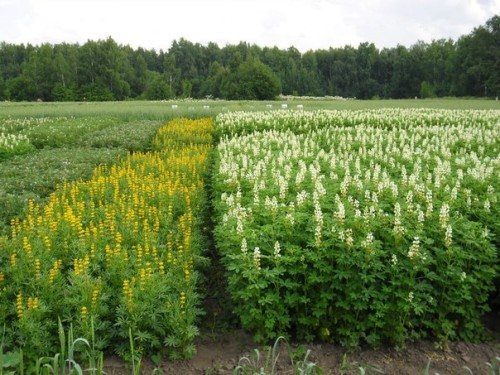

Siderata
From time immemorial, green manure plants have been used by nature and man as a natural fertilizer. Now undeservedly forgotten.
Of course, such a “green manure” requires a much greater investment of time and additional attention. At first glance, it is easier and faster to use the products of the chemical industry for plant nutrition, because mineral fertilizers will do an excellent job with this task. However, nature for millions of years managed on its own and did not resort to the help of artificial synthesis. And the taste of a vegetable, fruit or berry grown without chemicals, is it really an insufficient reward for work and patience?
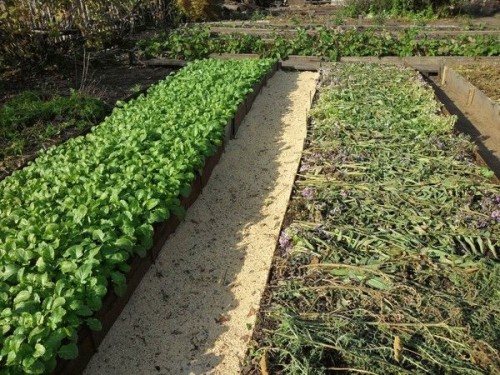

Siderata in the garden
Siderata are plants that quickly gain green mass, which are mowed and embedded in the soil, or left on the surface as a soil protective layer, and the roots of plants remaining in the ground rot, enriching it and forming air ducts. At the same time, they will only decorate your site, since most of them are a beautiful type of plant.
♦ Enrich the soil with nitrogen - after the death of the root system and the aboveground part of the plant, organic matter containing nitrogen passes into the soil.
♦ Loosens the soil and improves its structure - overgrown roots leave numerous tubules, thereby improving the water and air regime of the soil.
♦ Protect the soil from erosion - siderates, as it were, sew the soil from the inside with roots and at the same time cover it with a dense leaf cover on the surface.
♦ Enrich the soil with nutrients - nutrition is extracted from the lower layers, inaccessible to many cultivated plants, thanks to the deeply penetrating powerful root system.
♦ Suppress the growth of weeds - due to thickened plantings, as well as specific secretions of the roots.
♦ With solid sowing, green manure plants in hot summer time do not allow the soil to overheat, keeping it moist and cool.
♦ Suppress the reproduction of pests and diseases - again thanks to the specific secretions of the roots.
♦ Shade the soil - after cutting or dying off, the green mass serves as a natural mulch.
♦ Enrich the soil with organic matter - under the influence of microorganisms and worms, plant residues are converted into humus.
♦ Reproduction of earthworms and soil-forming microorganisms - this is facilitated by a sufficient amount of nutrition and the absence of disturbance from constant mechanical and chemical soil treatments.
♦ Getting rid of soil fatigue - microorganisms, multiplying well in a favorable environment, have time to process all root secretions, including inhibitors.
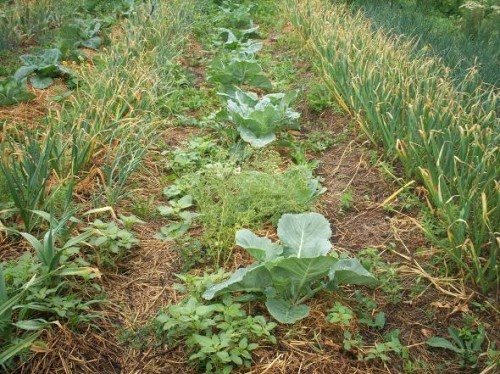

Siderata in the garden
Also, green manure is used in gardens to improve the composition of the soil and its structuring. The main purpose of growing green manure in the garden is to protect the soil from weeds, weathering and crusting on the surface of the earth after rain and watering. But it is worth remembering that in this case it is necessary to have sufficient moisture in the soil, otherwise garden plants will suffer.
If the soil is severely depleted and low fertile, then siderates should be grown for a full gardening season - from early spring to late autumn and winter, and next spring, cutting off some and embedding them in the ground, the next ones are immediately sown in order to fill the soil with nutrients as much as possible. In this case, the site is completely occupied by green manure plants.
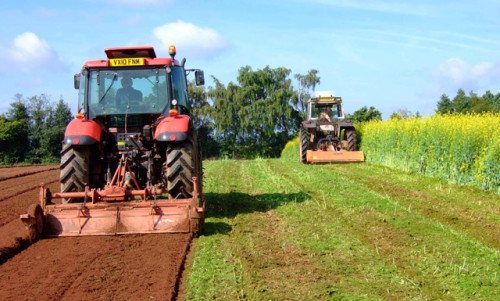

Siderata
Sowing winter green manures, after clearing the beds from garden plants, protects the soil from wind and water erosion, and the green manures left for the winter retain snow, which contributes to less freezing of the soil and saturation of it with moisture.
If soil fertility is at medium and high levels, then green fertilizers can be sown before or after the main crop, or in mixed plantings - the main crop and green manure are simultaneously grown on the same plot (combining in one bed, a bed through a bed).
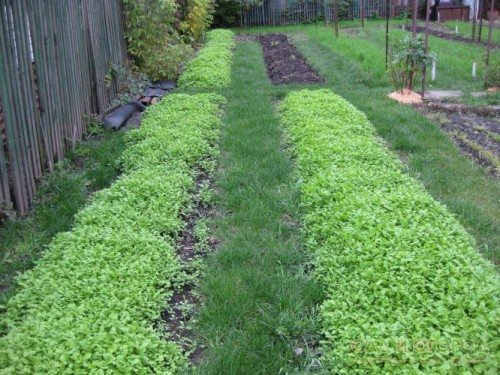

Siderata
As siderates in garden plots, mainly annuals are used, less - perennials, most often from the legume family and plants that give a powerful green mass and have phytosanitary properties.
To choose a green fertilizer that precedes the main crop, it is necessary to take into account that plants of the same family often consume the same nutrients from the soil, have common diseases and pests, therefore it is desirable that the green manure and the main crop are not from the same family.
Who can be a green manure from plants?
Legumesis probably the most numerous and well-known species. These are herbaceous plants capable of "extracting" nitrogen from the air. These include: peas, chickpeas, beans, beans, soybeans, lentils. And herbs: vetch, annual lupine, sainfoin, mouse peas, grass plots, alfalfa and clover. When planting clover and alfalfa, one must take into account their ability to grow quickly and braid everything with roots. Simple trimming or mowing is not a problem for them.
The next, but no less famous and significant, are cereals: wheat, rye, barley, oats and corn. They sprout quickly and are not afraid of frost. In addition, these are winter crops, which, having sown in the fall, can be used in the spring. When planting winter crops, their seeds must be applied to a depth of 5 cm and sprinkled with earth.
Further Cruciferous - early green manures, which are represented by annual and perennial grasses and shrubs: rapeseed, rape, oil radish and mustard. Cabbage is also cruciferous, but this is rather the main crop.
Green manure plants
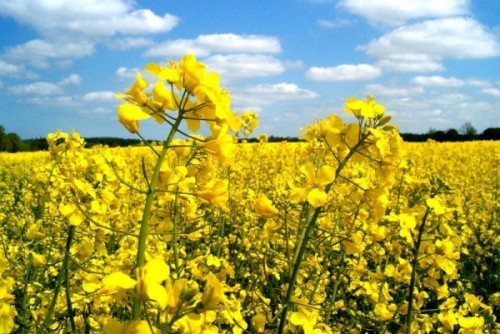

Rape
Rape - a culture widely used in agriculture. It is curious that the plant is not found anywhere in the wild, although it has been known to people for a very long time.
In the scientific world, there is an assumption that rapeseed arose from the crossing of winter rape and garden cabbage. Where this happened is unknown, debate among botanists about the alleged origin of the rapeseed continues.
Rape has a developed root system and has the ability to improve the quality and structure of the soil, increase its fertility. The ability of rapeseed to rapidly grow a huge amount of green mass in cold spring and autumn periods is highly appreciated. Rape biomass, easily decomposing, becomes a valuable easily digestible fertilizer that enriches the soil with phosphorus, sulfur, organic matter, and humus.
It is second only to leguminous green manures in terms of nitrogen content. Rape, like green manure, can compete even with manure in its nutritional capacity. Due to the high content of essential oils, it heals the soil and protects various crops from pests and pathogens. In addition, rapeseed - like green manure - successfully suppresses the growth of weeds, therefore it is often planted in the aisles of perennial fruit and berry crops, in particular strawberries. Solid crops promote the binding of nitrates and reduce their leaching into groundwater.
There are spring and winter forms of the plant, which can sometimes change from one to another. Winter rape is more productive than spring rape, therefore it is more profitable to cultivate it.
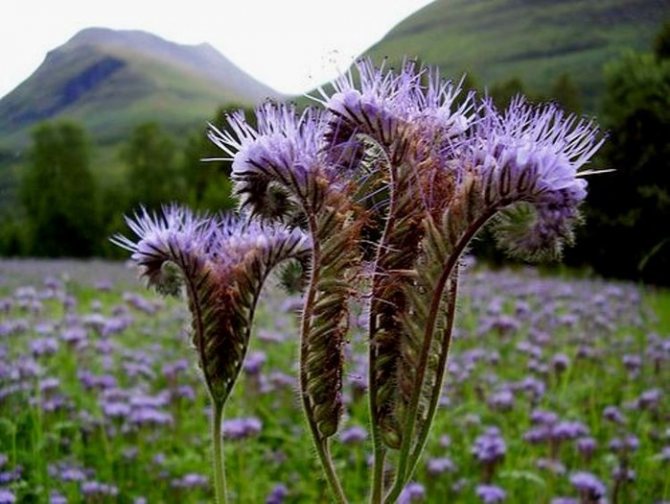

Phacelia
Phacelia. An annual plant from the aquiformes family. It is also valuable as a honey plant. Like all green manures, it grows quickly, and on any type of soil, and accumulates green mass.
The biggest advantage of this green manure is that it can be followed by any crop. Phacelia belongs to the gimlet family, to which none of the cultivated plants of the middle lane belongs.It can be sown before and after any vegetables, grains and herbs. Application rates - 8-10 g / sq. Due to its "class affiliation", this plant is suitable for fertilizing lands for cabbage, radishes, turnips, since they are more often than others affected by pests.
Phacelia emerges and develops very quickly (45-55 days), forming lush bunches of greenery growing from one root. It got its name from the shape of the aboveground part, since in Latin, Phacelia is a bundle. Outwardly, she looks very attractive. Purple flowers and carved leaves look decorative and will be appropriate for filling empty spaces in flower beds, flower beds and high ridges.
Phacelia embedded in the soil increases its fertility no less than cow dung. Putting tops into the soil (about 100 kg / hundred square meters) is equivalent to using 1 ton of humus on the same plot of land. But it is possible to prepare plant biomass much faster, and it will cost less than organic fertilizers of animal origin.
Another very useful property of this flower, which is not found in other plants belonging to the conventional class of "green fertilizers" - its nectar attracts entomophages that destroy pests. Moths, aphids and leafworms disappear from the infield. Phacelia is often planted as a protective barrier for potatoes in order to protect the planting from pests. The wireworm does not tolerate the neighborhood with it, and locusts and soil nematodes simply die when the fungicides secreted by its flowers are inhaled. At the same time, this flower does not have a negative effect on bees, and is an excellent honey plant. Some beekeepers specifically plant phacelia in whole plantations in order to obtain flower honey with excellent taste.
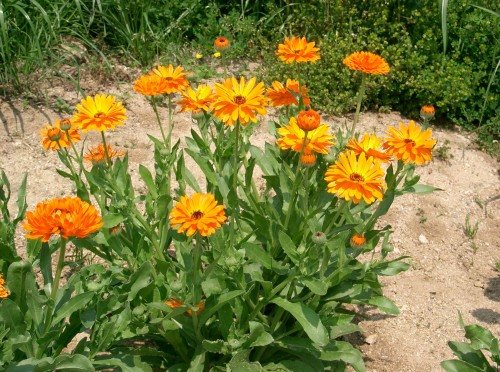

Calendula
Calendula belongs to the Aster family. Herbaceous one - or perennial plant, less often a shrub or small tree. Calendula as a siderat is also not often found, but this medicinal plant has all the properties that we expect from a good siderat and even more. Calendula grows rapidly and gains green mass, seeds can be collected for free in any city flower bed, has a phenomenal healing effect on the soil. Calendula repels the Colorado potato beetle, therefore it is often grown in joint plantings with potatoes and eggplants.
Sowing calendula between the beds of garden and garden crops allows rational use of the land, and also helps in the fight against butterflies and ticks. Neighborhood with calendula can save asters from black legs, and gladioli from thrips. It is the best green manure for tomatoes.
Seed consumption rate per one hundred square meters: 100-150 grams. Calendula is recommended to be planted in early August, cut off after a month and a half before flowering and left before winter.
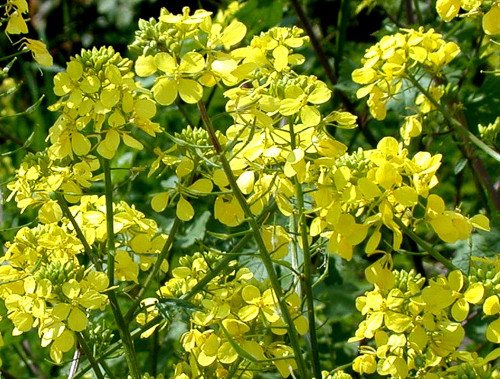

Mustard white
White mustard. This cold-resistant green manure can be grown and buried several times per season. The last time it is planted before winter, a few weeks before the onset of cold weather. This is done so that the green mass is "beaten" by the cold, and it would remain to rot under a layer of snow. The decay processes will continue for some time, after the onset of negative temperatures, due to the internal heat released during the decomposition of plant organic matter. It is enough to turn green manure fertilizers into humus, which will be very useful for plants in spring.
Mustard grows amicably, and very quickly gains vegetative mass. It is very important not to "miss" the moment when the stems begin to harden. Greens must be mowed until they turn yellow, before the first flowers appear, as soon as the first ovaries of buds have filled.
The minimum period from sowing to planting this plant in the soil is five weeks, but if possible, it is better to wait all eight. When calculating the timing of harvesting, it should be borne in mind that in hot weather, the stems harden faster, in cold weather - slower, so in autumn and spring you can leave greens in the beds for a long time.
Mustard is usually sown "randomly", with the exception of those cases when it is used to protect plants from pests. Then the in-line method is applied. The seed consumption rate of this fertilizer is 4-7 g per 1 sq. If you sow more, then the plantings will thicken, and rotting of greenery on the vine may begin.
To accelerate the maturation of vegetable humus, the green mass obtained from mustard plantings can be watered with a biostimulant. For this purpose, Baikal is perfect, which is diluted in a ratio of 1: 1000 (a drop per liter of water), and the mowed grass is sprayed with the solution with a spray bottle. Under the influence of live bacteria contained in the preparation, the grass rot faster and becomes part of the soil system.
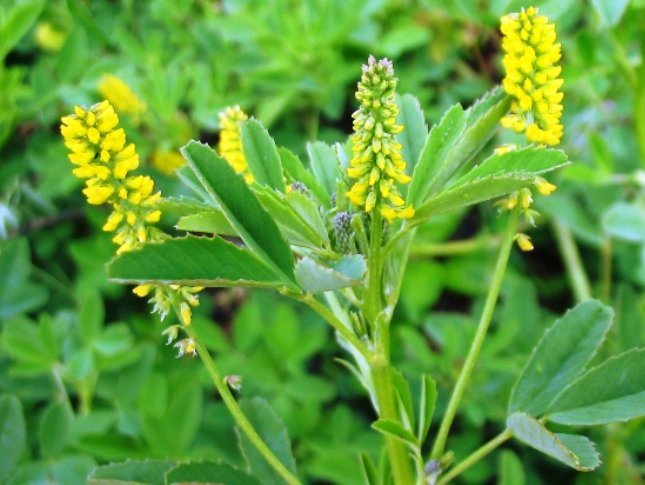

Donnik
Donnik. Previously, this herb was used as a fodder crop for livestock. But then they noticed that when plowing the fields, where the sweet clover grew, the land gave richer yields than in the fields that were sown with other grasses. After that, the sweet clover began to be used as a siderat. It is a biennial plant that is grown as an annual. Melilot is unpretentious, hardy and grows quickly. It belongs to the legume family, so it can accumulate nitrogen in the root system. Its roots penetrate deep into the ground, and have a large number of branches. Thanks to the powerful root system of this plant, there is no need to dig up the ground after cutting it. It will be loose without additional processing.
A feature of the cultivation of sweet clover is that the most useful is not the aboveground, but the underground part. Therefore, you can cut the plant in 3-4 weeks after germination. If you let it outgrow, it will become too hard for further processing, and the "pipes" from its stems will stick out of the garden for a couple of seasons, not decorating the garden at all.
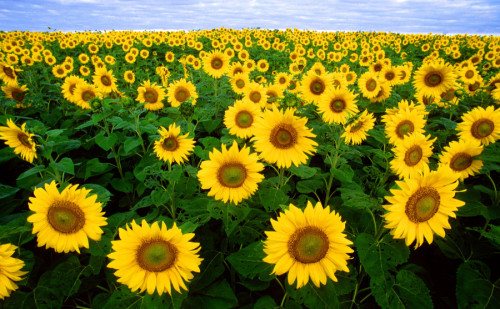

Sunflower
There is another striking representative of the Astrovian - Sunflower. It can also be used as a green manure, just keep in mind that its stem, like corn, quickly becomes tough and therefore slowly decomposes. It is best used as protection from direct sunlight or as a support for other plants.
Vika (mouse peas) - the plant is early ripening, and has a short growing season, which allows it to be used as a catch crop between plantings of main crops. For example, it can be planted in beds intended for seedlings of tomatoes, peppers and eggplants. It can also be sown in front of melons and gourds. Pumpkin, zucchini, squash, planted "on vetch", give excellent harvests.
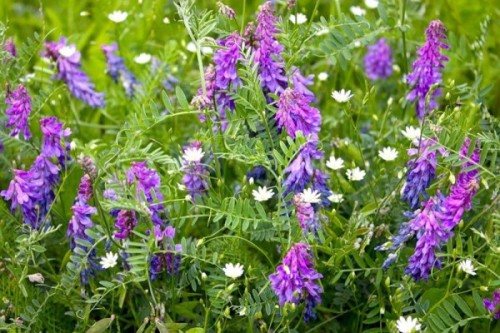

Vika (mouse peas)
Planting of green manure is carried out throughout the growing season, as soon as temperatures above zero are established. Sowing rate - 1.5 kg per one hundred square meters. The seeding depth is 1-3 cm. It is not necessary deeper, otherwise the plant will not be able to penetrate the surface layer of the soil. To accelerate the emergence of seedlings, the plot can be watered with EM fertilizers, it is cheap and fast.
Vetch is often included in a mixture containing green manure plants such as rye, oats, rapeseed and ryegrass. This is done to obtain the optimal composition of vermicompost, which is formed after mowing these crops, since this plant accumulates mainly nitrogen. "Mouse peas" belong to the legume family, and, accordingly, has a similar structure. On its roots, the same nitrogenous nodules are formed, which accumulate this element. Peas, beans and beans should not be planted after it. But potatoes, cabbage, radishes, cucumbers and greens will be excellent follow-up crops.
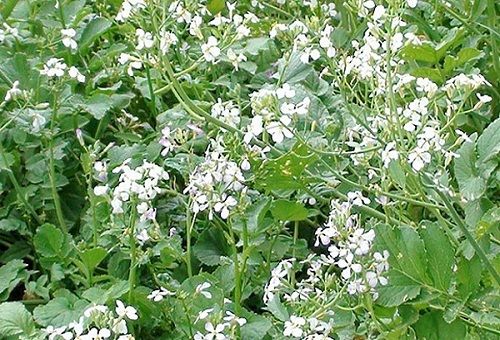

Oil radish
Oil radish - a unique green manure, with a rapidly growing aerial part. In 6-7 weeks, it can increase its vegetative mass by 4-5 times. It is popular among gardeners as a natural "agrokiller". Radish suppresses all weeds, even creeping wheatgrass.
This green manure is not only an active supplier of biomass. Radish is a natural doctor and earth cleaner. It successfully fights diseases such as cabbage keel and nematode. It must be planted on lands that have been affected by various diseases and insect pests for several seasons, and the soil will become healthy again.
It is best to sow radish on fresh plowing; it loves soft soil. Seed consumption - 300 g per hundred square meters. 4 weeks after the emergence of full shoots, the aerial part of the plant is excised with a shovel, and dug up together with the soil. The thickest stems are best composted.
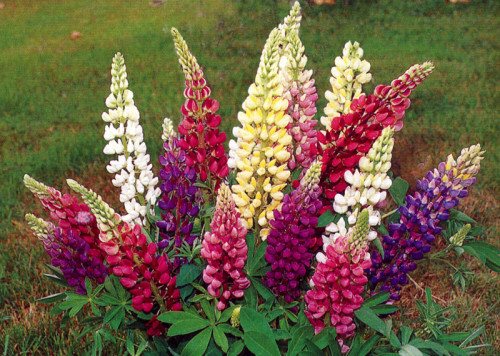

Lupine
Lupine. Common lupine is considered one of the oldest green manures in the history of agriculture. To enrich the soil, poor in nitrogen, it was used in Greece, more than two thousand years ago. Gardeners completely buried the trunk and leaves without roots in the near-trunk circle of a fruit tree, and there was enough nitrogen for that for several months.
This plant belongs to the legume family, respectively, beans, peas and beans cannot be planted after it, these crops have common pests. Tomatoes, cabbage, peppers will be excellent followers for lupine. And for potatoes, this beautiful flower will be the best predecessor.
The powerful roots of the plant are an active leavening agent, penetrating deeply into the soil. In parallel, they have another positive effect - they saturate all soil horizons with nitrogenous bacteria. Lupine plantings are capable of accumulating about 200 kg of nitrogen per hectare in the ground.
This green manure is planted in early spring, in a row method. Seed consumption (and they are quite large) - 4-5 per sq. When the lupine reaches the age of 5-7 weeks, its tops are plowed into the ground. Even if it bloomed, this is not scary, the most important thing is to prevent the formation of seeds, since at this stage of plant development, the stem becomes tough and does not rot well in the soil.
The great advantage of the plant can be considered a tap root system, which goes deep into the ground, and receives most of the nutrients from the deep layers, without depleting the upper fertile layer. At the same time, vermicompost, obtained from the aerial parts of lupine, per 1 sq. M. replaces 4 kg of manure, or 40-50 g of urea.
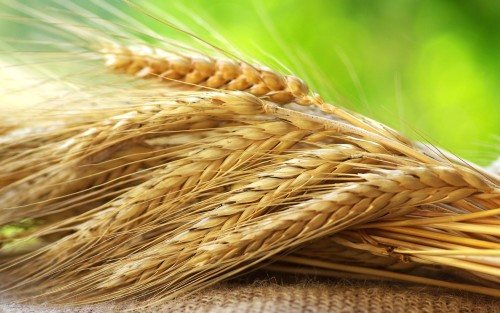

Rye
Rye. In many regions of the country, it is customary to sow the garden with this cereal after digging up potatoes. The rye bushes well, and builds up a large green mass, reaching 200-300 kg per hundred square meters. This green manure is planted both in winter and in spring, the planting time does not affect its quality. The special value of winter rye is that it actively increases its biological mass even at rather low temperatures, and winter crops survive even in snowless winters, with frosts down to -25 ° C.
The downside of all cereals grown to enrich the soil, including rye, is the complexity of their subsequent processing and plowing. The stems have a fairly strong structure, decompose for a long time, and cling to the plowshares, which have to be cleaned all the time. Another disadvantage of this winter green manure can be considered that it dries up the soil greatly, so it is impossible to sow rye in the garden between the trees.
Otherwise, this cereal is an excellent fertilizer, the seeds of which are inexpensive and therefore available to everyone. Rye is undemanding to the quality and thickness of the soil layer, perfectly sods loose soils, easily tolerates high acidity. Since this plant has a fibrous root system, it easily retains nutrients in the upper soil horizon, preventing them from being washed out with melt water and rainwater.
The big advantage of this green manure fertilizer is that when decomposing, it saturates the soil not only with nitrogen, but also with calcium. Microorganisms contained in cereal biomass create conditions for the absorption of difficult-to-digest phosphorus compounds, dissolving them.Accordingly, a complete NPK-complex of nutrients remains in the ground, which allows any culture-followers to fully develop.
The aboveground part of cereals after cutting is used not only for plowing. The resulting straw is used as mulch. It provides excellent protection of the soil from drying out, and does not allow weed seeds to break through to the surface. Subsequently, decomposing, fresh straw becomes part of the garden bed, turning into vermicompost.
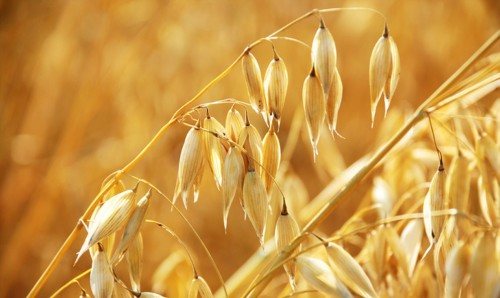

Oats
Oats. This cereal crop is used as green manure less often than rye. But this is more an accident than a pattern. The plant has all the positive qualities of rye, while it also wins over it in some respects. For example, oats are even more unpretentious. It can be sown on acidic podzolic soil, clay, and even peat - it will grow everywhere.
As an element of crop rotation, it is sown after legumes, preparing the land for potatoes. Despite the apparent weakness of the fibrous root system, this plant perfectly loosens the earth to a great depth, enriching it with oxygen, and creating a structure that is comfortable for cultivated plants. Oats saturates the upper soil layer with nitrogen and potassium, and, like rye, decomposes difficult-to-digest phosphorus compounds.
The seeds of this culture are planted, scattering them over the surface of a previously loosened plot of land, in early spring, as soon as it will be possible to enter the garden. Do not be afraid of dirt and cold - oats love them, and these parameters do not affect its germination. On the contrary, in late March - early April, optimal conditions are created for the germination of oats, since they can feed on soil moisture from the melted snow. The seeding rate is 1.5-2.1 kg per hundred square meters, the seeding depth of seed is 4-5 cm.
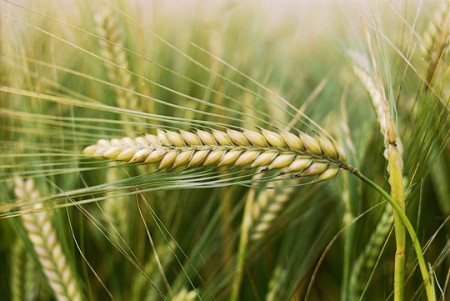

Barley
Barley as siderat is good as well as rye or oats. It also structures the soil well, suppresses most weeds and quickly gains green mass. But barley has its own special advantage: it is drought-resistant, in contrast to the same oats. Therefore, in areas where droughts are frequent, it is better to prefer barley as green manure. Barley is very good for early spring planting, it can withstand frosts down to -5 ° C. Seed consumption rate per one hundred square meters: 1.8-2 kilograms. Mowed in a month and a half after disembarkation.
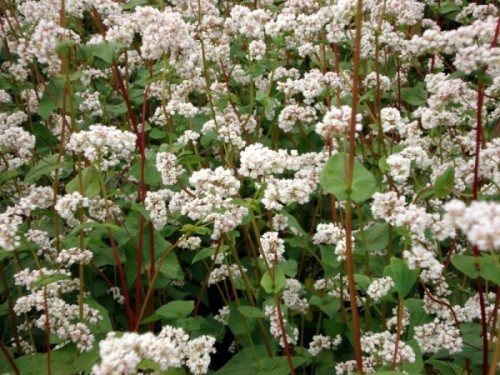

Buckwheat
Buckwheat - one of the record holders in terms of growth rate, it quickly reaches a height of half a meter, and even manages to grow 1.5 meters of roots. This green manure is not afraid of drought and does not dry out the soil.
Very often buckwheat is planted in the near-trunk circles of fruit trees and bushes. Buckwheat leaves behind colins (substances that inhibit the development of subsequent plants) less than other green manure plants. Buckwheat is recommended to be used as a green manure on poor, acidic and heavy soils.
It will grow anywhere, and after mowing will significantly enrich the soil with phosphates and potassium. Suppresses perennial weeds, especially wheatgrass. Seed consumption rate per one hundred square meters: 600 grams. Buckwheat is sown in late spring, in May, as it is thermophilic. Mow the green mass before flowering. You can sow buckwheat before winter.
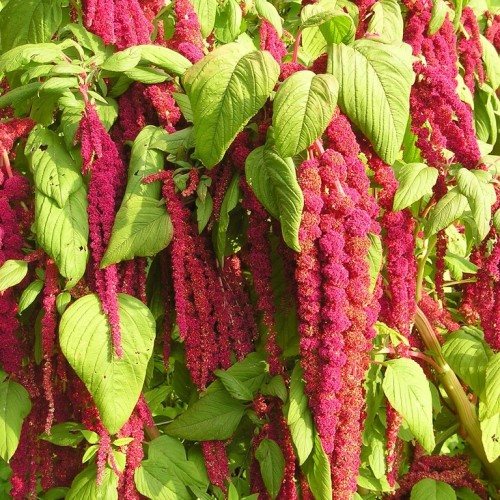

Amaranth
And finally Amaranth. It is not often used as a green manure in our plots, most often it is grown as a vegetable crop or for obtaining seeds. It is no less important as a green manure than all the previous ones, because it contains essential amino acids, a large amount of protein and minerals. This plant does not have any special requirements for the soil; it grows even on salt marshes. Does not like waterlogging, drought-resistant, practically not susceptible to disease. Amaranth roots go deep into the soil (up to 2 meters), improving its structure. Since amaranth is thermophilic, it is planted either in late spring in a specially designated area, or in the summer after harvesting early crops.The landing rate is 15 grams per hundred square meters. Before sowing, 2 teaspoons of amaranth seeds are mixed with a glass of sand and must be rolled for better contact with the ground. The green mass of amaranth is harvested before frosts, or before flowering.
| Growing potatoes in oats Agricultural technologies, like any others, do not stand still. In modern horticulture, the technology of growing crops without prior plowing of the land is increasingly being used. It allows you to save not only energy and time, but also to get excellent harvests. Siderata, as part of a crop-free farming culture, are actively used in this system. Oats can be not only a supplier of vermicompost. His can be used for potatoes by growing tubers in oat straw mulch. Moreover, on the plot, which is planned for this culture, you do not even have to remove the grass, it will disappear by itself, passing into the composition of the nutrient soil. It is only necessary to slightly push it apart, and in between to make grooves in which oats are planted.
When the siderata and weeds grow up enough, they are mowed under the root with a flat cutter, and, having made a small depression in the soil, they plant a potato there, lightly sprinkling it with a layer of earth. The sprouts that appear are mulched with straw and grass, and when they become very large, they gradually add other green waste, for example, the grass left after mowing the lawn. Most importantly, it is necessary to block access to the tubers of the sun's rays, which will "green" them, making the potatoes unsuitable for human consumption. After the autumn harvesting of potatoes, which, by the way, will become a very clean and fast process, the field must be sown with oats again, and continue to do this every year. In a couple of years, without digging, the soil structure will be completely restored, and this plot of land will give consistently high yields. |
Siderates can be conditionally divided into groups according to their functions
♦ Accumulation of nitrogen from the atmosphere - legumes;
♦ Conversion of phosphates into digestible forms - legumes, mustard and buckwheat;
♦ Assimilation of nitrogen from the soil, protection against soil mineralization and leaching of nutrients into the subsoil - cruciferous, cereals;
♦ Deep loosening of the soil - mustard, radish, lupine, sainfoin, buckwheat;
♦ Protection against nematodes - legumes, sunflowers, phacelia, ryegrass.
Approximate sowing dates for some green manure crops
♦ Any terms - sweet clover, mustard, phacelia.
♦ In early spring - spring - lupine, buckwheat, oats, alfalfa.
♦ Early summer - summer - mustard, phacelia, clover, alfalfa, vetch, peas, clover, rapeseed.
♦ In autumn - clover, winter rye, winter oats, oil radish.
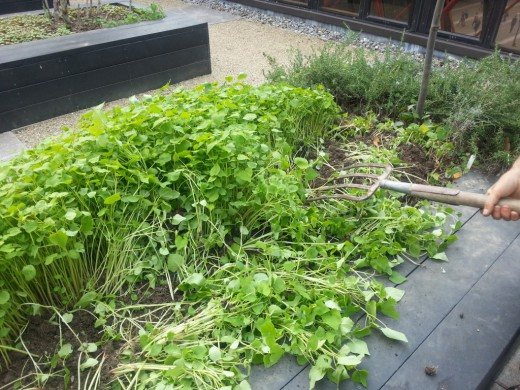

Sealing siderates in the garden
When sowing siderates in the garden, an ordinary method is used with a row spacing of 15 cm and a continuous one, taking into account the seeding rates for various plants, conditions and purposes. Plants grow faster and better if, after sowing, the soil is rolled (increasing the area of contact of the seed with the soil) and moistened.
In traditional farming, soil with green manure is dug up, however, digging or plowing violates the structure of the soil and destroys beneficial microorganisms. Therefore, in natural agriculture, siderates are cut with a flat-cutting tool to a depth of 5 cm, leaving roots that, after decomposition, form tubule systems, and the green mass is left on the garden bed, preferably covering them with a mulching layer so that they do not dry out.
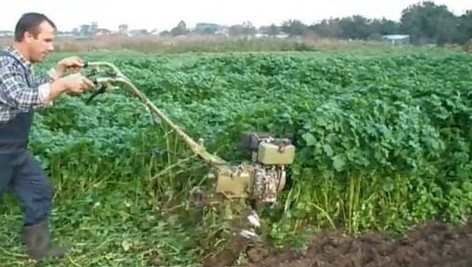

Sealing siderates using a walk-behind tractor
Young plants, when decomposed, release a large amount of nitrogen, quickly decompose and the main crop is planted 3-4 weeks after their incorporation. Mature plants with a tough stem form carbon compounds, consume nitrogen and take much longer to decompose, so it is advisable to avoid coarsening of the plants and remove them when they gain sufficient green mass.
Mowed and introduced into the soil green manure plants gradually decompose under the influence of soil microorganisms, earthworms and other soil living creatures and turn into organic matter and humus, releasing nutrients that are readily available for subsequent cultivated plants.
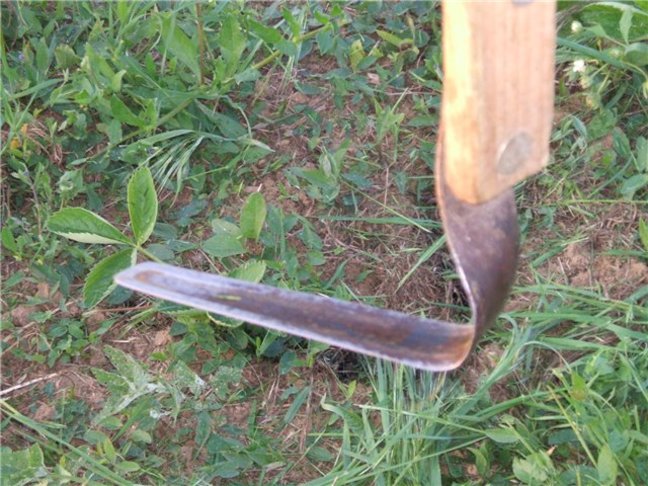

Sealing siderates using a Fokin plane cutter
Red clover, sweet clover, sainfoin and sowing alfalfa are used for greening in gardens. If the garden is young, then it is better to sow it with annuals: beans, peas, rank, seradella, lupine and winter vetch. Perennials, when a large above-ground mass is formed, are mowed, but removed from the garden area, forming a lawn. Perennial green manures are harvested and plowed into the ground in the last year of their life, before or in the middle of flowering, if possible without disturbing the structure of the soil, and after a couple of years the site is not sown to give time for the decomposition of the remaining roots.
It is also worth noting that tree trunks are rarely sown, they should be free of vegetation so that there is no negative impact on tree roots.
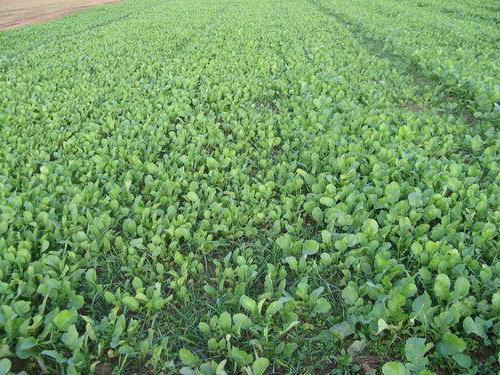

Siderata
The use of green fertilizers allows you to restore the soil balance, save money on purchased fertilizing, and grow environmentally friendly products. The use of green manure helps to create a new humus layer, which was destroyed by traditional farming, when all nutrients were removed from the soil with the resulting products. The soil enriched with natural methods will be transformed, and will certainly thank you for all your efforts with abundant harvests of environmentally friendly vegetables and fruits.
You might be interested in:
Methods for combating diseases and pests of gladioli
Ekoduki
Unusual tips for protecting and caring for garden plants
Wormwood, dimple, quinoa are trendy weeds
How to determine the acidity of the soil without instruments
Siderata: what is it and how to use them in the country
Today you can hear quite a lot of good things about siderates from gardeners and farming enthusiasts. These plants grow very quickly and act as an excellent green fertilizer, which is so necessary at every summer cottage.
The main task and ability of green manure plants is to restore fertility and complete soil renewal. With the help of green manure plants, you can turn the poorest and most neglected soil into nutritious and fertile soil in a short time.
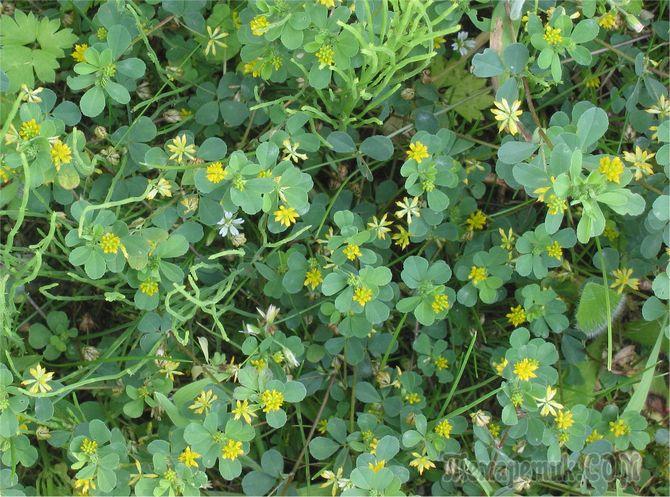

How do they affect the soil
Planting green manure entails only a number of general consequences. The rest are individual, depending on the chosen crop of green fertilizer. The choice is made taking into account the nature of the soil on the site. Some siderates are suitable only for light soils. Other green fertilizers are cultivated on medium-heavy soils. There are also such siderates who love heavy soil.
The soil is known to be neutral, acidic and alkaline. Here, too, siderates are divided into groups. Their effect on the ground is as follows:
- Amaranths loosen the earth better than others and enrich it with nitrogen. The roots of the plants of the group go 2 meters deep. Therefore, amaranths are planted on light soils. Their mineral base is washed out into the deep layers of the soil. Crops with a shallow root system cannot get food from there. Therefore, this work falls on amaranth siderates.
- Compositae are champions in green mass gain, and they also suppress nematodes. This is a type of roundworms that harm fruit and vegetable crops.
- Buckwheat crops enrich the land with organic matter, potassium and phosphorus. Good loosening performance.
- Hydrophilic green manure can make neutral soil out of acidic soil. Still green fertilizers of the group suppress harmful microorganisms well and saturate the soil with oxygen.
- Crucifers give almost as much green mass as Compositae. Another group of siderates is blocked by the leaching of minerals from it.Poorly soluble phosphates with the help of cruciferous plants become suitable "for consumption." Organic acids released by green fertilizers serve as phosphate solvents. They loosen the siderates of the category, mainly, the lower layers of the soil.
- Legumes, on the other hand, loosen the top layer of the earth. Like cruciferous plants, siderates of the group help release poorly soluble phosphates. Legumes also actively saturate the soil with nitrogen and prevent the reproduction of nematodes.
- Cereal green fertilizers saturate the soil with nitrogen and potassium. The soil increases the moisture permeability threshold. Nematodes also surrender before cereals.
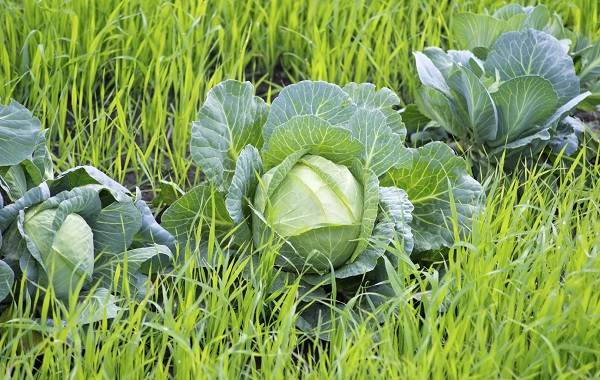

In addition to pluses, siderates also have minuses. Compositae, for example, severely deplete the soil. Therefore, the use of siderates of the group is justified on fertile, but nematode-infected soils.
How to use green manure
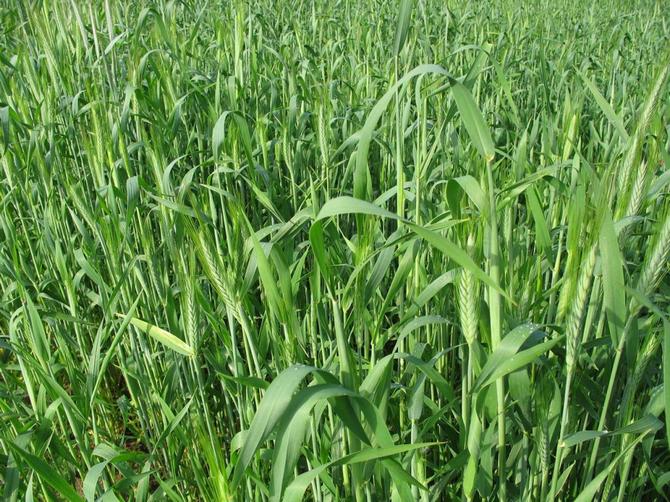

You can sow green manure plants in different ways: together with vegetable crops or between plantings (before or after). Siderates are sown in early spring or early autumn.
For example, in the future vegetable garden (for growing cabbage, zucchini, cucumbers), you can sow green manure plants at the very beginning of spring. After all, all the same, the land will remain bare almost until the end of the spring season, because these heat-loving vegetable crops are not grown in open ground before May.
As soon as the snow melts in the area, you can immediately sow mustard or watercress. These cover plants grow a large amount of green mass in a short time, which, after mowing, is useful as mulch or organic fertilizer.
The root part of the plants must be left in the ground. Microorganisms in the soil will begin to convert plant residues into substances useful for soil and plants. You can help them speed up the process by using a drug with effective microorganisms.
It is advisable to start planting vegetable crops in this bed only 15-20 days after mowing green manure plants.
It is necessary to prepare the soil in the beds for early ripening vegetables (for example, radishes or lettuce leaves) after the last harvest (at the very beginning of autumn). In a month - one and a half before the cold weather, the siderates manage to grow about 40 centimeters of green mass and more than 30 centimeters of the root part. With the arrival of the first frosts, the green mass of green manure dies and the active work of earthworms, bacteria and various microorganisms begins. Throughout the winter season, there is a gradual renewal and improvement of the soil composition. By early spring, this land plot will be completely ready for planting vegetables.
When to sow green manure
Green manure plants are recommended to be sown from early spring and after harvest. The work is planned individually, taking into account the availability of suitable sites and the need.
In autumn
Autumn crops reliably cover the surface of the earth, preventing it from being washed out during the rainy season. The risk of erosion is avoided. Before the onset of winter, after harvesting, the sowing of green manure crops begins. In order for the plants to grow green mass, the work is completed in October.
There are several ways to plant green manure, usually the most common is used, requiring little effort and expense, using hand tools.
The method of greenhouse greenhouse cultivation is practiced, the seeding period is at least 5-6 weeks before the planned work. The sown plants are dug up before winter, in this form they leave the site until spring.
Advice! In order for the seedlings to be uniform, it is recommended to mix the seeds with sand or sawdust.
Sowing green manures in autumn is the most common technique among owners of household plots and large agricultural enterprises.
Before winter
Siderata before winter is a method that does not involve digging up the soil. Usually, the planted plants are left at a later date until spring and dug up after the onset of heat.This method is practiced in cases where the site is not planned to be planted in the spring. You can sow between beds to keep weeds out, or place crops between intended rows of vegetables and horticultural crops.
Benefits of pre-winter green manure crops:
- more time is allocated for spring field work;
- due to the long term of green manure in the ground, the soil receives the maximum amount of nutrients;
- with the onset of spring moisture remains.
In spring, green mass is effectively used for mulching and for composting. In a greenhouse where it is planned to grow early seedlings, late sowing is not recommended. Siderata should be dug up in the fall.
In the spring
After the snow melts, when the soil warms up, it is time to sow winter-hardy varieties of green manure plants:
- spring and winter rapeseed;
- rye;
- oats;
- mustard;
- phacelia.
Nitrogen in their composition is retained in the ground after decomposition. By the time of planting in May, the siderates have time to decompose. It is recommended to close up plants planted at least 3 weeks before the start of field work. Planting green manure in spring involves only varieties with the earliest ripening period.
Successful sideration rules
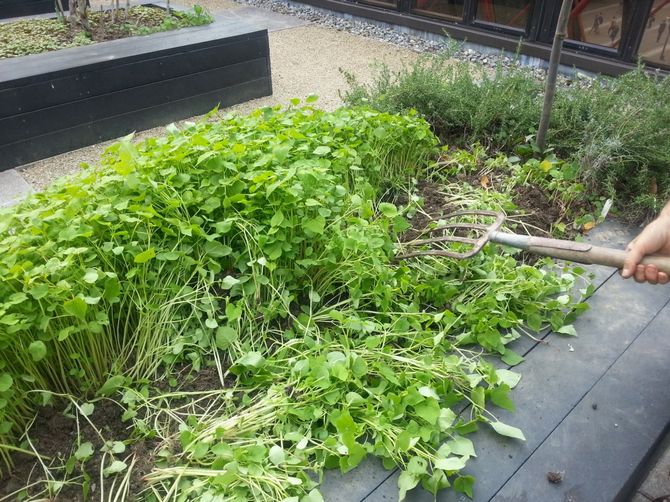

- Sowing seeds of green manure plants is carried out only in well-moistened and loose soil.
- The germination period of seeds can be minimized if, when planting, they are rolled a little so that there is more contact with the soil.
- Birds cause great harm in beds with green manure plants. They can eat seeds that are on the surface of the beds and then all your efforts will be in vain. You can save plants from such a feathered invasion with the help of an ordinary scarecrow.
- It is not recommended to use for green manure plants that belong to the same family as the vegetable crops intended for planting. This relationship presupposes the same soil nutrition and similar infectious diseases.
- It is not recommended to break the integrity of the soil in the garden bed by digging, and even more so together with the green mass. All beneficial microorganisms are destroyed in the process of digging, and negative changes occur in the composition of the soil. The green part of the plant should be mowed or cut and used for mulch or organic additives.
- If the siderates of spring planting are not cut off before flowering, then the stems become stiff, which further slows down the process of their decomposition. Therefore, it is recommended to harvest the green mass before it blooms.
Which siderates are better
Sideral cultures are divided into several groups, each of which has multiple advantages and disadvantages. They partially compensate for the nitrogen concentration and contribute to the accumulation of humus.
Siderata are divided into several categories:
- cereals;
- legumes;
- buckwheat;
- cruciferous.
The choice of seeds is determined taking into account compatibility, climatic conditions and soil quality.
Mustard
The use of mustard as a green manure involves embedding the green mass in the soil.
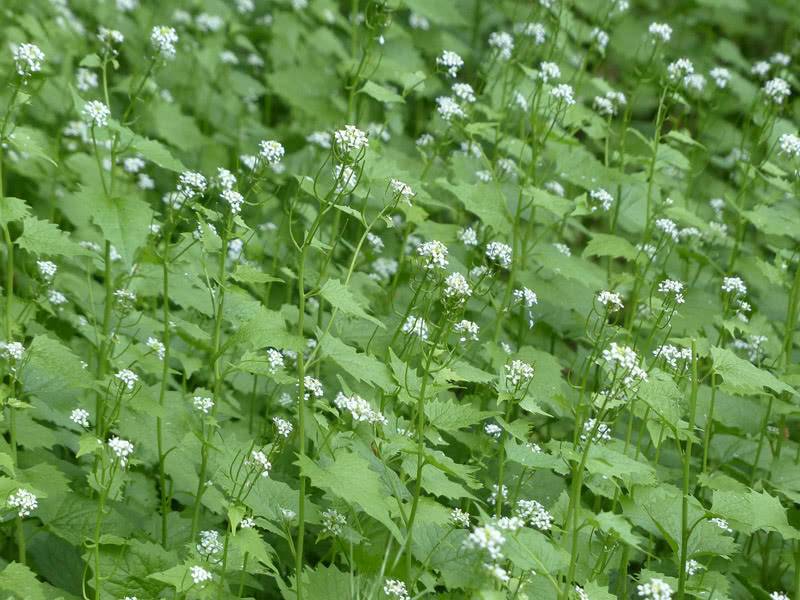

Advantages:
- cleansing the soil from late blight, scab, putrefactive bacteria;
- pest control: wireworm, slugs and moths;
- improving the quality of the soil;
- preventing leaching;
- protection of soil from freezing.
Mustard is unpretentious, grows on any kind of soil, in any climatic conditions. High germination and frost resistance have provided this crop with a leading position among green manure plants.
Phacelia
A popular annual plant like green manure is practiced to improve and increase yields in several ways. To increase the fertility of the soil, seeds are sown several times during the growing season.
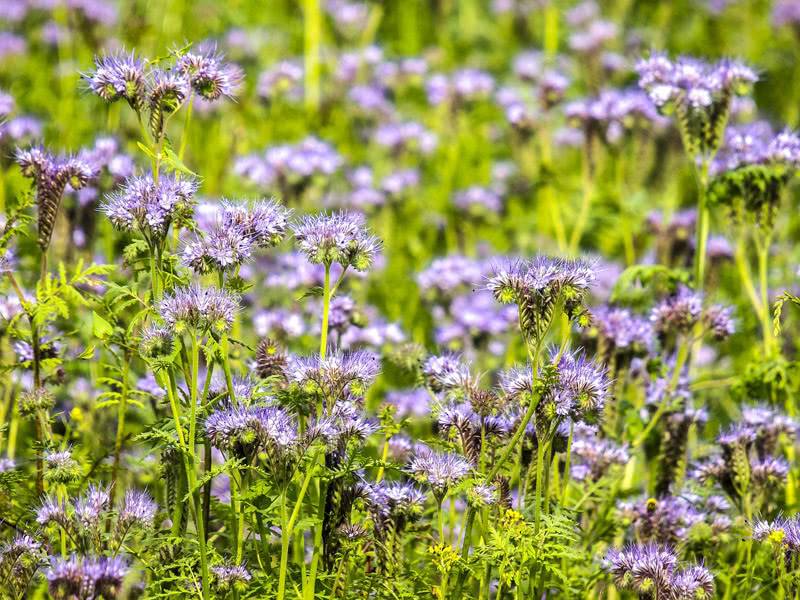

The most effective period is early spring and late autumn. It is important that the seeds have time to germinate before the first frost begins.With the onset of spring, sowing begins immediately after the snow melts.
Small seeds are mixed with sand and embedded to a depth of 2-3 cm. To accelerate germination, the soil is additionally moistened. After the beginning of flowering, it is important to mow the phacelia in time, while the green mass is tender and soft and has not had time to coarse. If the decomposition process is delayed, pathogenic microelements accumulate in the green manure.
Advice! It is recommended to use special solutions that accelerate the decomposition of green manure.
After seeding in the soil, the next batch of seeds is sown immediately. Depending on the climate, the procedure can be repeated several times without interruption, until the very frost.
Rye
Unpretentiousness to the quality of the soil makes rye popular among other green manures; it grows and bears fruit on almost any soil.
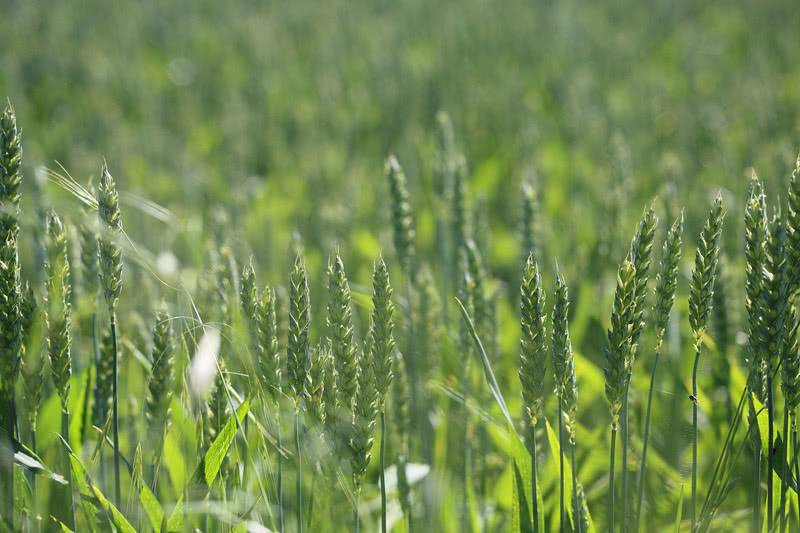

Rye as a green fertilizer is productive under winter crops. After harvesting vegetable crops of a late ripening period, sowing most siderates is already useless.
The cereal seeds sown in September - October have time to fully develop. In spring, the sprouts begin to actively grow and turn green, and by May, rye can already be embedded in the ground.
The cereal has characteristic advantages:
- accelerated growth rates;
- developed tillering;
- soil insulation;
- moisture retention.
Reference! Rye tends to dry out the soil, so it is not recommended to use it as a green manure in hot arid regions.
When mowing green mass, rye quickly recovers.
Wheat
Due to the large amount of greenery and the ability to bush and grow, wheat is sown like green manure 1.5 months before the planned mowing.
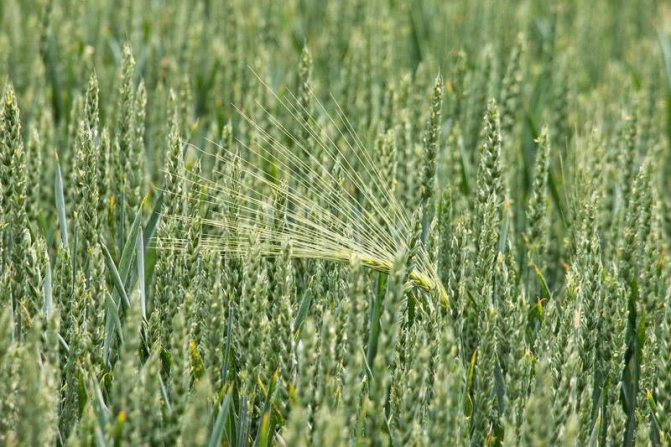

The preference is given to winter wheat, it is more frost-resistant, unpretentious and resistant to diseases and pests. To enrich poor depleted soils, sowing is carried out three times during the growing season.
Oil radish
This radish variety has a characteristic feature - it does not form a root crop in a plant. The roots go deeper into the ground, developing a root system, thereby forming a lush aerial part of green leaves.
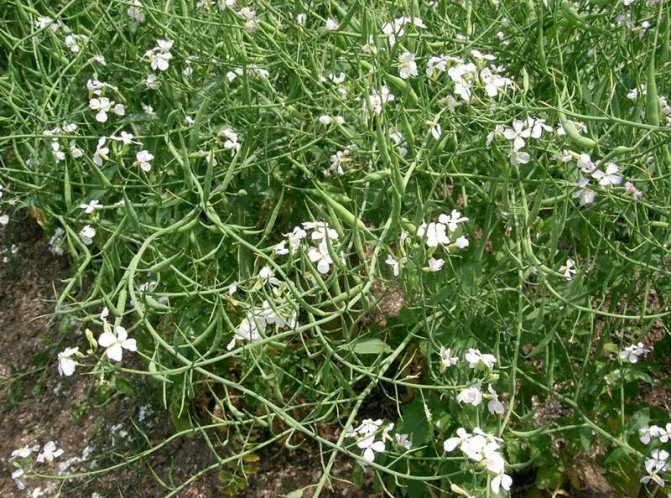

The vegetable culture is quite unpretentious to growing conditions, it is distinguished by drought resistance and frost resistance. The period before mowing the tops is 40 days, which allows it to be used in areas with short summers and severe winters.
Buckwheat
Buckwheat vegetation period is up to 80 days. The culture is demanding on weather conditions and watering. In a dry season, it simply will not bring the expected result.
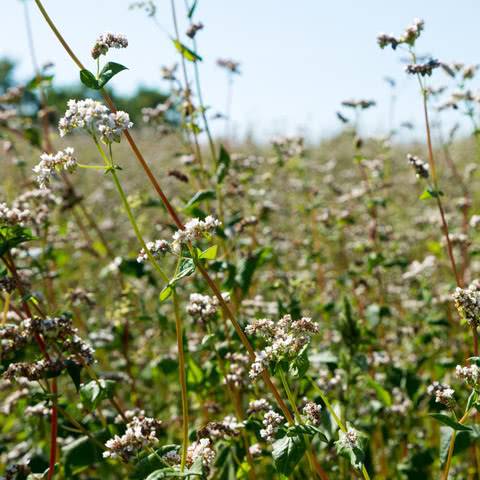

It is advisable to sow heat-loving buckwheat for green manure in the spring, when the threat of frost has passed.
Barley
The barley is mowed before flowering when it has reached the maximum amount of nutrients. It cannot be kept to full maturity - the stems become rough, decompose for a long time in the soil after digging.
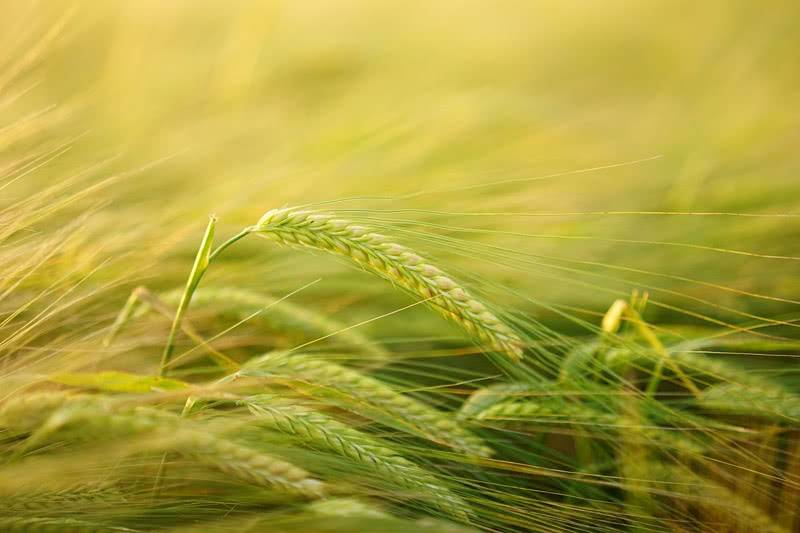

Advice! It is not recommended to use barley before planting root crops - there is a high probability of wireworm breeding.
The ear begins to form after 8 weeks, so the barley needs to be mowed in time. In warm regions, the method can be used twice a season.
Peas
Peas reduce the acidity of the soil, restore balance and structure. Due to the presence of deep roots, it is able to get nutrients from the lower layers of the soil. The maximum amount of nutrients is accumulated during the formation of the pods. Close up when it reaches 15 cm in height.
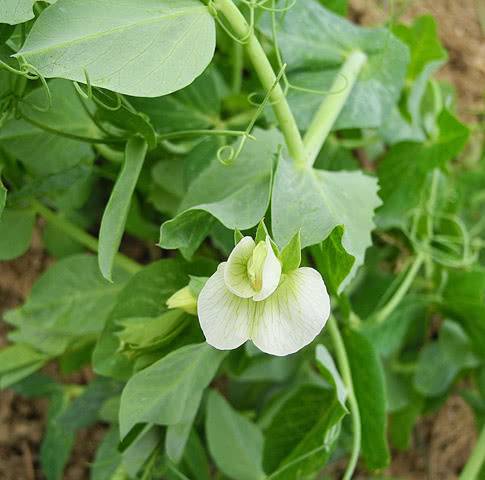

Reference! Peas are an irreplaceable crop rich in protein. Used effectively for composting.
After embedding in the soil, at least 2 weeks must pass. In autumn, they are sown in late August - early September, after the harvest.
Clover
This perennial green manure is planted in areas designated for growing vegetables. Clover is grown for two years, then the site is dug up. As a green manure, it is also planted around trees and shrubs.
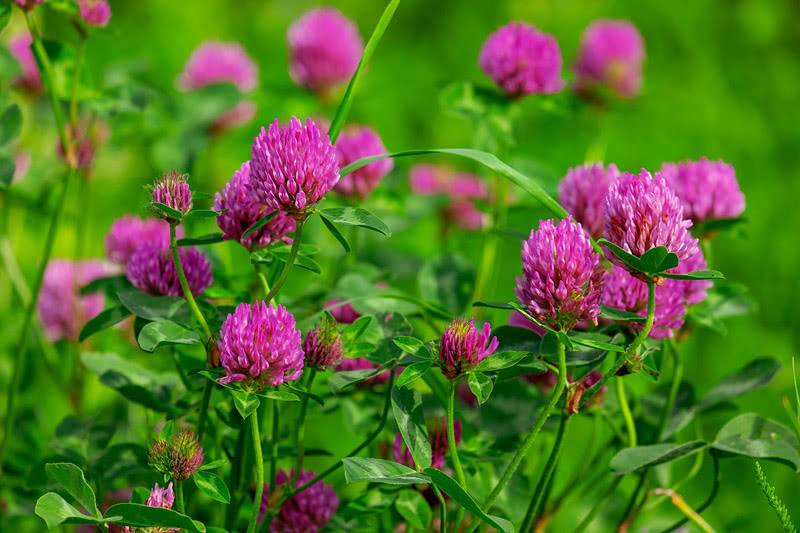

The plant is unpretentious, grows on any soil, in any climatic conditions. During the growing season, it is mowed repeatedly. Hay is also distinguished by its high qualities in livestock feeding.
Donnik
A fast-growing plant is closed up when the stems reach a height of 30-40 cm. An unpretentious culture is sometimes affected by powdery mildew.
Linen
Flax has little green mass, its value is in phytosanitary properties. The tannin secreted by its foliage repels pests.
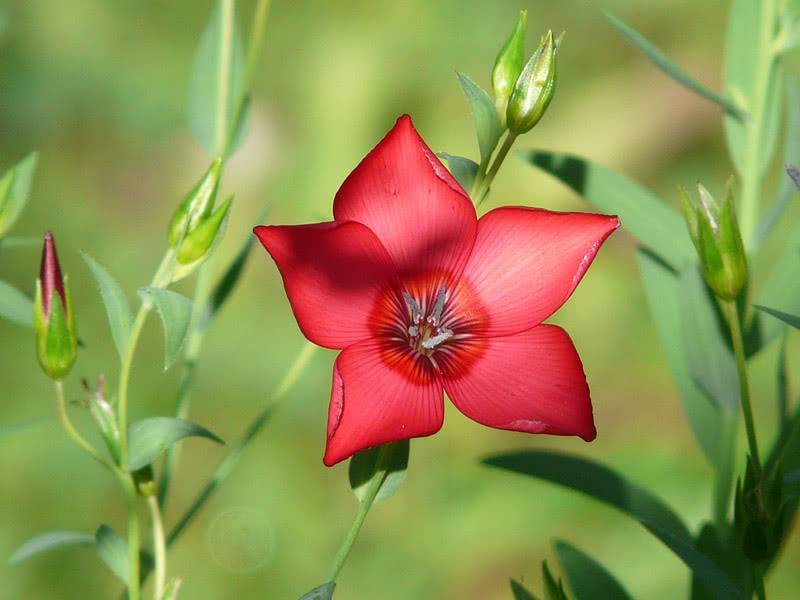

Sowing flax next to potatoes is practiced. It performs a protective function against parasites, without the use of chemicals. Greens are laid for composting. It is necessary to mow flax on time, during the budding period, before flowering.
One of the advantages of flax is frost resistance. Flax is planted in April, when the threat of frost has passed and the air temperature is at least 7 degrees. Although flax germinates even at 2-5 ° C. Early sowing is preferable as long as there is enough moisture in the soil, which is necessary to stimulate growth.
Soy
Soy, as an organic fertilizer, is popular with vegetable growers due to its features and technical characteristics.
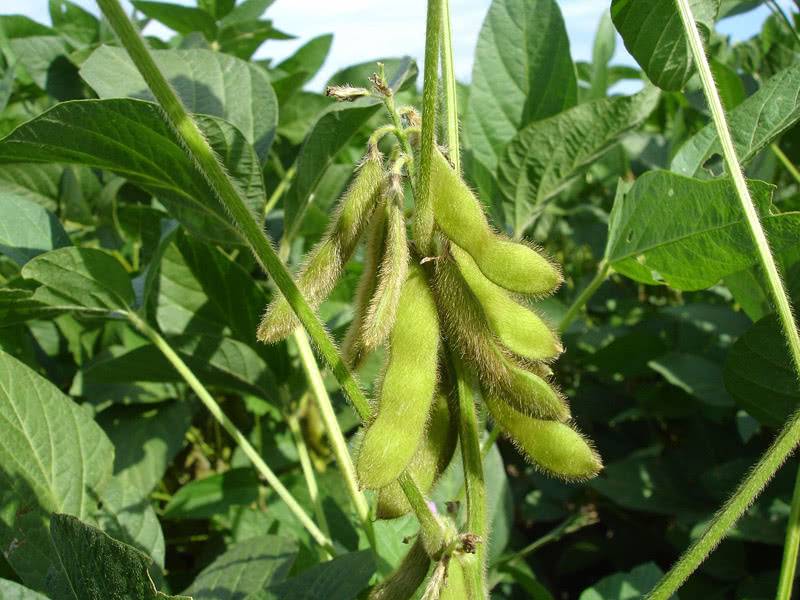

Siderat has predominant differences:
- extracts and accumulates nitrogen in the soil;
- extracts nutrients from the lower layers of the soil;
- promotes the assimilation of nutrients: nitrogen, phosphorus, potassium, calcium.
After the growth of green mass, it is embedded in the ground.
Millet
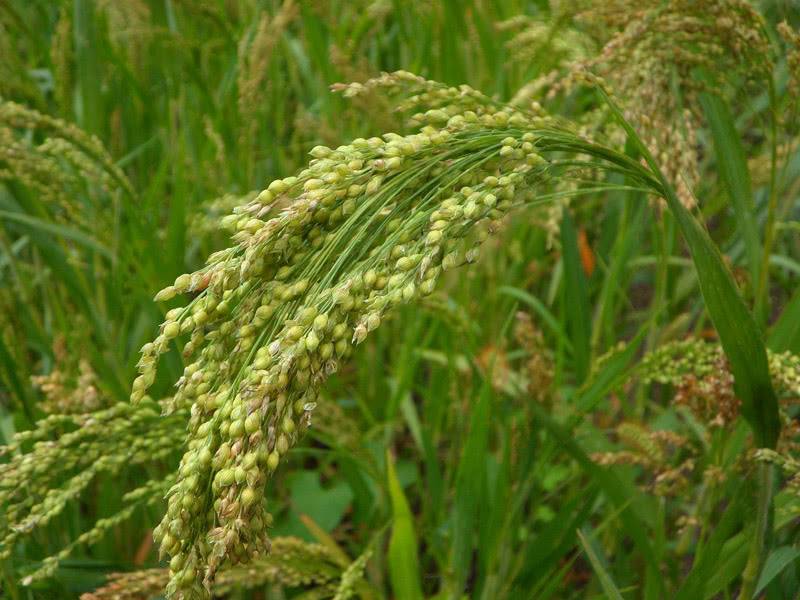

Drought-resistant millet is used universally and without restrictions. The plant is mowed while the green mass is still soft and the ear is not formed. You can cover green parts, mow for compost or livestock feed, leaving only the roots to rot.
Siderata flowers
Flowers with a short ripening period are also recommended for greening:
- marigold;
- zinnia;
- calendula;
- nasturtium.
Interesting video on the topic:
Reference! Flower crops are actively used due to the pungent odor that repels parasites.
Decorating the site with ornamental plants, after flowering they are dug up, leaving them as fertilizer for the soil.
Useful properties of green manure
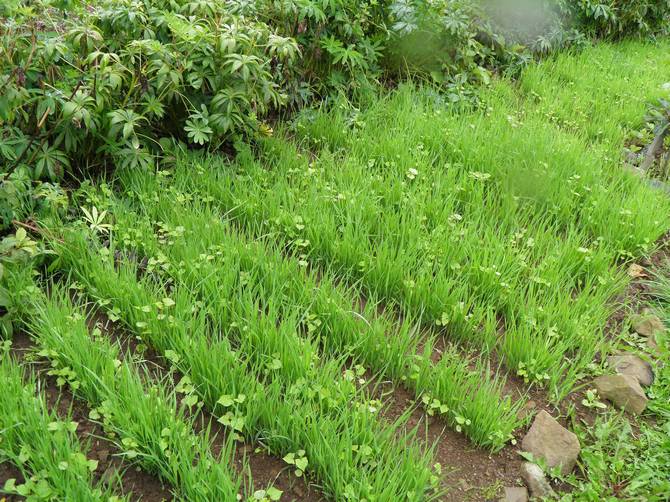

Is green manure really much more useful than conventional mineral fertilizers? Is it worth cultivating them, spending time and energy on caring for them? Let's try to figure out what is the advantage of green manure plants and their benefits.
If you look closely at the life of plants in the wild, you will notice a lot of interesting and instructive things. For many tens and hundreds of years, plants grow and develop themselves, then shed their foliage or completely die, a decomposition process takes place in the soil. In the future, this soil becomes an excellent food for the next generation of plants. It provides all the necessary nutrients and becomes fertile on its own.
This happens from generation to generation. The natural fertile layer teaches nature itself to create, without the use of various fertilizers and digging. Representatives of the flora take care of themselves.
If you follow all the rules of green manure, then the poorest and most depleted soil will very soon "come to life" and will give all the plants on it need.
- Siderata is an opportunity to maintain the balance of all necessary useful elements in the soil: nitrogen, potassium, calcium, phosphorus and organic compounds.
- The soil will not become fertile without earthworms, small insects, bacteria and microorganisms. Green manure plants contribute to their appearance and create the most favorable conditions for living.
- The great advantage of these green fertilizers is that they completely eliminate weeds from the garden beds. The carpet from the sowing of green manure is so dense that there is no way even a small weed blade of grass can germinate.
- The root system of green manure plants is designed in such a way that they, as it were, pull up all the nutrients from the depths to the soil surface.At the same time, the soil becomes loose, with a normal level of acidity, and with great opportunities for the passage of moisture and air.
- Plants - siderates do not allow moisture to evaporate from the soil and do not allow the soil to overheat. The dense green carpet is a kind of protective layer.
- Siderata sown in the autumn season will protect the soil in the area from torrential rains and strong gusts of wind, prevent its deep freezing and keep the snow cover until spring.
- Using joint planting of vegetable and green manure crops, you can protect plants from pests and diseases.
Which are the best?
Before sowing green manure, the question of their choice always arises. There are no “bad” or “good” plants. From a wide variety of species, it is important for a gardener to choose those green fertilizers that will benefit exactly on his site.
You can sow what you have in the garden, but be sure to meet the planting dates for subsequent crops.
Annuals
Most of the known green manure plants recommended for planting in the garden are annuals.
| Common annual green manure | |||||
| Culture | Features of the | When to plant | Application | What do they give | |
| Fodder beans | Combination with other legumes is acceptable. Planting green manure plants on moist, neutral or slightly acidic garden soils. | End of July, early August. In a warmer climate - "before winter". | Restoration of clay-forming and peat-bog soils. Formation of garden soil in fruit trees. | Excess moisture is removed, saturated with nitrogen. Reduces acidity. | |
| Vika | Planting the next crop in 3 weeks. The oatmeal mixture is preserved when the temperature falls to minus 7 degrees. | From mid-April days to mid-May. For winter time - when the main crop is harvested. | Saving seedlings of nightshade, melons, pumpkin seeds. For 3 years, a mixture of vetch with cereals will turn any soil into loose black soil. | Enriches the soil with nitrogen and potassium. The tomato yield is increased by 45%. | |
| Mustard | Loves light and moisture. Mustard mustard does not tolerate the close approach of groundwater. | Planting siderates in spring 30 days before potatoes, in autumn - before cold weather. You can - between the main cultures. | Destruction of harmful insects and weeds in the garden. Excellent honey plant. Improving the water holding capacity and air permeability of the ground cover. Salvation from cold weather and erosion. | Nitrogen, potash and phosphorus "storage". Organic acids come from the roots, they destroy pathogens and bind metals. | |
| Buckwheat | Not afraid of drought, does not dry the earth. Grows on any soil. Sensitive to cold. | Planting in late spring (May) or winter. | Cultivation of the soil under trees and bushes. Restoring lifeless lands. Suppression of perennial weeds. Culture-honey plant. | The mown green manure gives potassium and phosphates to the soil, enriches it with organic matter. Green mass and husks are used for mulch in the garden. | |
| Lupine - blue, yellow, white. | One of the oldest green manure plants for the garden. Dislikes clay soils. Resistant to freezing. | In early spring. | Increasing the fertility of loams and sandstones. Manure replacement. Scaring off soil-dwelling pests. | Saturates all soil horizons with nitrogen, turns insoluble phosphates into nutrients. Raises water capacity and "airiness" of the soil. | |
| Oats | It grows on almost any soil in the garden. Loves moisture. Sensitive to heat during flowering. During the period of milk maturity, it is exposed to cold. | Last days of March, early April. | Preparing the soil for different crops. | It feeds the upper layers with nitrogen, potassium and organic matter. | |
| Oil radish | Garden plant green manure active growth. Prefers loose soil. Calmly accepts late sowing. | The first days of August. | Cleansing the soil, primarily from long-term active pests. Overgrown stems are used for compost. | Binds nitrogen, allows you to reduce the amount of organic fertilizers. | |
| Rye | It actively builds up biomass even in cold weather (up to 25 degrees). Strongly dries up the ground. The composition and acidity of the soil is any. | In spring or winter. | Creation of sod on loose soils. Enrichment and mulching of the soil of the vegetable garden. Protection against erosion, overheating, excess moisture, nematode damage. | Prevents useful soil elements from leaching out. It feeds the earth with nitrogen and potassium. | |
| Phacelia | Not afraid of any lands. Can be grown in the garden for more than one year. Accumulates a lot of greenery. | Multiple sowing per year is possible. Cruciferous plants are added in autumn plantings. | Improvement of soils of rocky and sandy type. Honey plant. There is complete freedom in choosing the predecessors and followers of the phacelia. Cleansing the land from any pests. Seedling protection. | It is not inferior in quality to the impact of humus at a much lower price. | |
A number of flowers are rightfully referred to as green manure plants that can be sown in the garden.
- Marigold. Destroy nematodes.
- Calendula. It drives away the Colorado potato beetle, ticks, keeps the soil from fusarium, saves flowers from black leg and thrips. Excellent green manure for tomatoes.
- Nasturtiums. They scare away cabbage caterpillars in the garden, inhibit rot in the roots.
Perennial
Greens of planting of a perennial cycle are used less often, although well-known green manure plants are also planted for the garden.
- Horned lyadvenets. Able to loosen heavy soils to a depth of 1.5 m. It accumulates calcium, phosphorus and a number of other useful substances.
- Donnik. Hardy, restores calcareous soils and "salt marshes", strengthens the slopes. He is equally disliked by nematodes, wireworms and mice. Resistant to cold and drought. Dislikes moisture and acidity.
- Clover. The effect of this plant appears in the garden after 2 years. Suitable for row spacing of fruit crops. White clover provides some nitrogen and potassium, and does not tolerate acidic soils. Sown in spring and summer. Red - perfectly accumulates nitrogen, grows on wet lands, planting in early summer. During the season, the garden is mowed up to 4 times.
- Alfalfa. The "family" of legumes provides the earth with organic matter, phosphorus and a lot of nitrogen. Siderat can be left for the winter. Reduces indicators of soil acidity. Up to 10 mows of greenery per growing season.
When planning the planting of plants, keep in mind that clover and alfalfa grow quickly and braid everything that comes across with roots!
The most common siderates
A large number of flora representatives can be used as green manure. It can be not only vegetables and cereals, but also several types of flowers and weeds.
- From the cruciferous family - radish, mustard, rape.
- From the legume family - soybeans, beans, lentils, peas, clover, alfalfa, chickpeas.
- From the family of cereals - wheat, rye, barley.
Calendula, sunflower, nettle, amaranth, buckwheat, phacelia and nasturtium have proven themselves excellently as green manure plants.
How to choose the right one?
Confidence in the positive effect of green manure on the soil and plants of subsequent planting gives the right choice of green fertilizers. When planting green manures, it is important to take into account the value of the acidity of the garden soil, its composition and a number of other important factors.
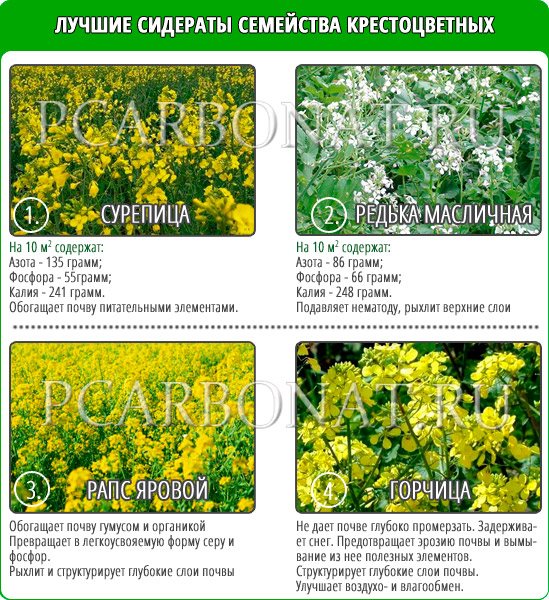

Suitable plant characteristics:
- Strong root system.
- Rapid build-up of "green" mass.
- Friendly shoots.
- Easy to collect seeds.
- Minimal (or absent) rest period.
- Cold snap resistance.
- Easy to care for.
Rules for choosing green manure plants for the garden:
- Do not sow plants of the same family one after another or on the same bed.
- GMO seeds are excluded.
- Plants from the cruciferous family can only be sown in the second half of summer to avoid the spread of the cruciferous flea.
It is useful to keep a table of plant compatibility in the garden and take into account the predecessors of vegetable crops.
Siderata for a garden and a summer residence
Annual plants planted on a land plot in order to improve the structure and composition of the soil are called siderates.
The roots of these plants create a whole network of tubules in the soil, loosen it, and at the same time are an excellent nutrient for underground inhabitants - various microorganisms, earthworms, etc. The green part of the plants protects the soil from overheating and drought, erosion by rains and gusts of wind. After death, green manure continues to be useful, turning into an excellent fertilizer and mulching material.
The primary purpose of green manure is to restore soil fertility, so they are grown as a natural fertilizer. Siderata have a different effect on the soil of dissimilar types.
- Plants strengthen the sandy soil by binding the loose soil with roots.
- Heavy clay soil is made lighter and looser. The root canals in the soil, created by green manure, provide improved water and air exchange.
- In addition, green manure can reduce soil acidity and improve the activity of microorganisms.
Which to choose
What siderates choose - a question with an ambiguous answer. From the previous chapters, it is clear that the selection of green fertilizer is based on the nature of the soil, climate, budget, previous and subsequent plantings, the presence of certain pests on the site. Aesthetic tasks also influence choice. Not everyone is satisfied with just a green meadow. If the task is to make it look like a flower bed, siderates with decorative flowers are chosen.
Let us also recall the melliferous nature of the flowers of some green fertilizers. For beekeepers best green manure - exactly they. Farmers are looking more at the suitability of green manure as livestock feed. Those who are fond of traditional medicine prefer to choose medicinal siderates. Gardeners try to sow edible plants.
If we take the average data, there are top 6 best siderates. It includes phacelia, oats, mustard, clover, lupine and sweet clover. When compiling the list, in addition to the listed selection factors, the following were taken into account: the range of sowing dates, the duration of the growing season, the volume of green mass per unit area, and the ease of germination.
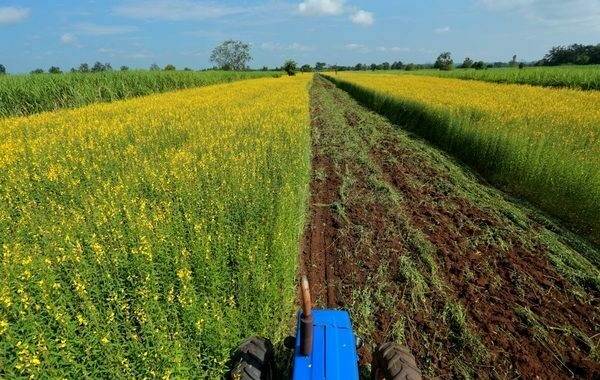

Note that some criteria for the selection of green manure are ambiguous, for example, the price. Seeds can be expensive but low in consumption. The expense of some budget options is so great that the total costs are compared, or even more. Therefore, it is important to consider that when spreading sowing:
- Reygrass seeds need 25 grams per square meter and, accordingly, 2.5 kilos per hundred square meters. A kilogram of seed costs a maximum of 125 rubles.
- It takes 2 kilograms of barley per hundred square meters. One costs about 25 rubles.
- Oats and wheat have the same consumption, but the price of a kilo is 5 rubles higher.
- A kilo of rye seeds at a 2-kilogram consumption per hundred square meters, on the contrary, costs up to 21 rubles.
- Buckwheat takes 1.5 kilograms of seeds per one hundred square meters. One costs 70 rubles.
- Sorghum needs 3 kilos. One kilogram costs about 50 rubles.
- A kilo of mustard seeds also costs about fifty, but the consumption is only 300 grams per hundred square meters.
- Alfalfa also takes 300 grams, but the price of a kilo exceeds a hundred rubles.
- Shrove radish requires 400 grams of seeds. A kilo costs about 40 rubles.
- Only 200 grams of rapeseed per one hundred square meters is needed. A kilo costs about 40 rubles.
- The consumption of red clover is equal to the consumption of rapeseed. Only the price of clover is not 40, but more than 100 rubles.
- Only 120 grams of white clover is used per hundred square meters. The cost of a kilo is 150 rubles.
- A kilo wiki also costs about 40 rubles, but the consumption per hundred square meters is equal to 2 thousand seeds.
- Field pea seeds need 1 kilogram. Its price is equal to 30 rubles.
- Sweet clover seeds per one hundred square meters are spent 280 grams. A kilo costs about 150 rubles.
However, not only the price and consumption are important, but also the germination of the green manure. It largely depends on the growing conditions and the correct planting.
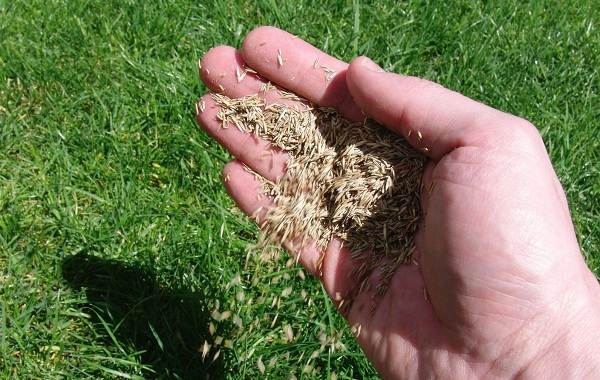

Planting green manure
The first sowing of these plants is done in early spring, before the main crops are planted. They are planted in the vacant place after harvesting.Siderata are planted in two ways.
- The soil is loosened with a hoe, after which grooves are made in it, into which the seeds are sown. Then the seeds are sprinkled with earth on top. As a rule, this method is used in the spring and summer.
- Seeds are scattered over the dug soil, and sprinkled on top with mulch or compost. This method is applicable in the fall.
Are there any disadvantages to growing green manure?
Often, out of inexperience, gardeners plant green manures thoughtlessly and as a result only worsen the situation.
- Some of the siderates, for example Donnik, are perennial, and therefore they germinate again in the same place after a certain time and this can ruin all plantings.
- It is important not to overexpose the fertilizing herbs. If seeds appear or the stem starts to grow stiff, it will be difficult to get rid of them completely, so they are removed during flowering.


Siderite and Vegetable Compatibility
- You should not grow green manures and crops from the same family on the same plot, otherwise they will greatly impoverish the land.
- It is worth adhering to the crop rotation and growing different green manures on the same site from year to year, otherwise many pests and diseases may appear.
The most popular siderates
Most plants with green manure qualities are from the families of cereals and legumes.
The root system of legumes is distinguished by the formation of special nodules, which contain many nitrogen-fixing microbes. Therefore, legumes feed the soil well with nitrogen.
Cereals accumulate humates in the soil and improve its structural layer. Nowadays, both monocultures of siderates and mixtures of these plants can be found on sale.
Peas increases nitrogen and phosphorus substances in the soil. It is planted as the main crop or green manure under trees and shrubs.
Beans perfectly improve the quality of heavy clay soil. They effectively reduce the acidity of the soil, while simultaneously saturating it with nitrogen. Beans like green manure can be planted in the fall. In the spring and summer months, the beans are recommended to be planted along with vetch and peas.
Another notable siderat is horned ice... It saturates the fertile soil layer with useful minerals. This plant starts growing even on wastelands, poor and heavy land plots. It is resistant to trampling and is often used for decorative gardening of a summer cottage. Sowing is carried out in spring and summer, simultaneously with legumes.
Alfalfa increases the quantitative composition of nitrogen, potassium and other minerals in the soil. It has a developed root system, alfalfa roots grow at least three meters in length. This green manure forms a lot of green mass, therefore it is also used as livestock feed.
Grows well on sandy and clayey land plots sweet clover... It has high drought and frost resistance.
Copes with green manure properties mustard... It improves the structure and composition of the soil, inhibits the development of weeds, repels pests, suppresses late blight and scab. Mustard roots grow over a meter in length. After cutting the green mass, the root system of the plants rots in the soil, forming a large number of tubules. Through them, air and water are able to penetrate deep enough. Mustard is sown in the fall, immediately after harvest, and in the spring, before sowing and planting of the main crops. In summer, white mustard is planted under fruit trees and bushes.
In this list of green manure crops, it should be noted and phacelia annual... As a green manure, it is suitable for any soil, being an excellent precursor for most vegetable crops. Throughout the season, from early spring to autumn, phacelia can be sown several times. Powerful roots nourish and loosen the ground, scare off pests, including nematodes, the voluminous green mass of the plant is suitable for livestock feed.
Sideration plants
There are people who mulch literally everything on their site, including paths. A side effect of this approach is getting rid of the bear - it does not live in cool, moist soil. But this is possible when there is a flood meadow or abandoned neighboring areas behind the fence - mow for yourself, and mulch. And if everyone around is just as smart, and the nearest meadow or grove is several (tens) kilometers away? Where to get good organic mulch?
Many people sow the garden with white clover, and the paths on the site with lawn grass or simply ryegrass. Here is a great source of excellent mulch, especially if your farm has a hopper lawnmower. But for those whose eyes are more accustomed to traditional beds, the agro-technique called "sideration" will greatly help. Its essence lies in growing industrial crops without obtaining a harvest from them, but using green and root mass as fertilizer.
Sideration is mainly used as a means of organizing a short crop rotation - in the fall, after harvesting the main crop (for example, potatoes), an intermediate crop (most often rye) is sown in its place, which is embedded in the soil either in the fall or, if the crop is winter, in spring.
Then the main crop takes up the area again.
Rules for the use of green manure on the site
It is necessary to plant these plants in compliance with the following recommendations:
- Before buying green manure, you must carefully study the technical description for each plant.
- Siderata are planted before planting the main crops and after harvesting.
- To get rid of weeds, you should sow green manures throughout the site, and then close them into the soil with a rake.
- You need to cut siderates two weeks before planting the main crops. During this period of time, all toxic compounds that could be synthesized by their root system will be washed out of the soil.
- The green mass of green manure should be left directly on the ground. Firstly, it will become mulch, and secondly, when decomposed, it will enrich the soil with nutrients.
- Before planting seedlings, you do not need to mow siderates. Wells are made right at the place of their growth, in which seedlings are planted. Siderata will protect young seedlings from bad weather and temperature extremes. Later, they should still be cut off, leaving them here in the garden as a mulching material.
- It is not recommended to plant green manures and vegetables belonging to the same family.
- You cannot plant the same siderates all the time, they need to be alternated using different types.
- They are engaged in cutting siderates until the seeds ripen on them, otherwise they will multiply and become commonplace weeds.
- The root system of the green manure should not be pulled out of the ground; only the ground part of them can be cut off.
When is the best time to plant?
Green fertilizers are planted more often in the autumn and spring seasons, although it is possible in the summer. The best time to plant green manure in the fall is the time after the release of the beds. In spring, beneficial plants should be sown several weeks before planting the main crops. Early ripening species are sown in May. In this case, the seedlings are determined directly into green fertilizers. Each landing time has its own advantages.
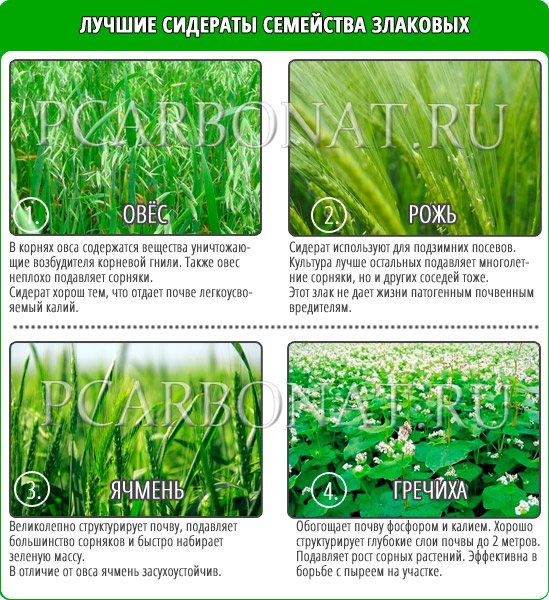

Benefits of spring and summer disembarkation
The early planting process is organized for warm-loving crops. So that the land in the garden does not stand bare, the spring planting of siderates is usually carried out immediately after the snow melts.
The advantages of sowing in spring:
- The weeds do not have time to "master" the land.
- Before planting the base crop, green manure grows good greens suitable for mulch and compost.
- Can protect seedlings.
The main planting is best done 2-3 weeks after mowing green fertilizers.
In late spring, it is customary to plant siderates in the garden, when they are planned to be left for the entire summer season.Such sowing allows the land to rest, which is not occupied by plantings this season. During the summer, young shoots are mowed in the garden and left on the site so that the rapidly decaying greens give the maximum amount of nutrients to the ground.
Benefits of autumn planting
It is best when a decision is made to plant green manure in the fall. Such plants "have time to do" especially a lot of useful things.
- Greenery and roots are actively growing.
- Protect the soil from erosion and swelling, loosen well.
- Contribute to its less freezing.
- They inhibit pathogens and weeds.
- They keep snow in the garden, which perfectly saturates the earth with moisture in spring.
- Green manure planted for the winter prevents nitrogen, potassium and magnesium from leaching out of the soil.
The green mass and roots that have matured over the winter give off a lot of substances useful for new plantings into the soil so that excellent yields grow. Already the first early plantings of the main crops receive clean and enriched soil "at their disposal".
Green fertilizers: how to use green manures correctly in the garden
The use of green manure crops to improve land fertility has been known for a long time. For decades, farmers have planted a variety of technical groundcover plants to prepare the land for use and to saturate the soil with organic matter during the off-season. Despite the fact that farmers actively introduce new methods of soil cultivation in agriculture every year, to date, no full-fledged alternative to green fertilizers, which are siderates, has been created.
These crops do not threaten the environment; they are distinguished by simple agricultural technology and availability. Their nature of impact on the soil is not limited only to the improvement of its composition. With the help of correctly selected green manures, you can get control over the spread of weeds in the field, prevent the growth of pathogens in the ground and avoid future damage to garden crops by agricultural pests. However, in order to appreciate the benefits of green fertilizers in practice, the farmer must first figure out how to use green manures correctly in the garden - how to grow them, whether to bury them, when to bury them, and only then move on to action. The summer resident learns about the features of cultivation, the intricacies of soil green manure and effective techniques for using green fertilizers from this review.
Siderata: pros and cons
The benefits of green manure have been proven by practice, their large selection allows you to select varieties according to compatibility.
It should be borne in mind that garden plants belong to certain families. After cruciferous green manure crops, it is contraindicated to place cruciferous vegetables in this area. And when using grain, there is a high probability of the appearance of a wireworm.
Over-saturation with green manure soil is impossible. Although there are recommended seeding rates. Each plant has its own pros and cons, so compatibility and specifications must be considered.
The use of green manure to improve the structure and mineral composition of the soil
Studying various green manure plants for a summer cottage, farmers often cannot make a choice. It should be said that all green fertilizers can be beneficial if used correctly, but for this you need to take into account several nuances when choosing seeds in garden centers.
Should I take into account the type of soil when choosing green manure?
When planting green fertilizers in a garden and a vegetable garden - green manures on which are designed to improve the structure of the land, the farmer must take into account the first nuance - the type of soil. Various families of green manure have a directed effect on the soil - some retain nitrogen in it, others neutralize acidity, and still others replenish the deficiency of potassium and magnesium.
Therefore, when deciding which green manure to sow between the rows of strawberries, tomato beds and flower beds in his country house, the gardener should be guided by the following principles:
- for acidic soil, it is better to choose green manure from a huge number of cereals;
- to improve the fertile properties of medium-heavy and light soils, it is worth purchasing seeds of leguminous ground cover;
- to balance the organic composition of light soils, you should pay attention to cruciferous plants;
- buckwheat crops have worked well for enriching depleted soils;
- light loamy soils will enrich amaranth green manure;
- for any type of soil, seeds of asteraceous and hydrophilic crops can be sown.
Siderata for weed control
The second caveat concerns the choice of green manure to control the spread of weeds on the site. Many green manures give good results in weed control. However, the best siderates from wheatgrass, quinoa, crabgrass, knotweed and other common garden weeds are representatives of the family of cereals (wheat, sorghum, rye, oats, barley) and legumes (clover, vetch, alfalfa, chickpeas, lupine, etc.). Also, the bruise siderat, belonging to the borage family, will help suppress the growth of weeds. These crops germinate very densely and sprout quickly, so the weeds have no chance to fill the garden during the season.
Disinfection of soil with green manure
If green manure is used to disinfect the soil, then it is important for the farmer to know which green manure disinfects the soil in the garden. As a rule, sowing of buckwheat, mustard, marigold and calendula gives good results. These plants suppress the colonies of pathogenic bacteria in the soil, and the farmer does not have to worry that in the coming season the crops on his land will suffer from various diseases caused by the presence of diseases in the soil.
You also need to consider other factors:
- climatic features of the region;
- crop rotation on the site (information is necessary in order to take into account the compatibility of vegetables and green manure, after which they will be planted in the field);
- the term for the green manure to reach the optimal vegetative volume, etc.
Having decided on the nuances listed above, the farmer can significantly narrow down the search and select for himself only two or three types of optimal green manure crops that will help achieve the desired improvements on a specific allotment of land. In addition, the farmer will understand whether it is possible to plant garlic in green manure and get a basic understanding of the compatibility of other popular garden crops with various types of green fertilizers.
This knowledge will help him plan the crop rotation in the best way and achieve the maximum yield of all crops planted in the beds. After the summer resident chooses the appropriate green fertilizers, he will need knowledge of what to do with the green manures planted in autumn and spring. The subtleties of this process will be highlighted further.
The use of green manure
The use of green manure allows you to abandon harmful chemical compounds. The cultivation of most varieties of annual plants is practiced. Seeding time: April - October.
What green manure under what crops to sow. Table:
| Siderata | Vegetable compatibility |
| Mustard Oil radish Rape Rapeseed | Tomatoes Potatoes Eggplant Squash Cucumbers Dill Carrots Parsley |
| Cereals | Zucchini Cucumbers Pumpkin Tomatoes Eggplant Potatoes |
| Clover Lupine Lentils Alfalfa Legumes | Cabbage Radish Radish Cucumber Squash Pepper |
Green manure crops are recommended to be periodically changed or sown in a complex manner.
For potatoes
The popular potato is widely grown and its yield depends on several factors. To obtain a high-quality harvest, several types of green manure are chosen:
- peas;
- Vika;
- lupine;
- sweet clover;
- alfalfa.


Lupine
Recommended time is the autumn period. They are buried in the ground until frost.Row spacings can be sown to prevent soil leaching, to protect plantings from parasites.
Under the bow
The following crops are most suitable for onions:
- peas;
- phacelia
- yellow lupine;
- garden bean;
- turnip.
To perform a protective function against weeds, crops are used in the spring and summer. To saturate the soil, it is recommended to perform manipulations in the fall.
Garlic
When growing garlic, it should be borne in mind that at least 2 weeks should pass from the moment of planting in the soil to planting spring garlic. Common crops for garlic are phacelia and mustard.
For tomatoes
Not all siderates are suitable for delicate and whimsical tomatoes. In priority:
- mustard white;
- Vika;
- phacelia;
- alfalfa;
- lupine.
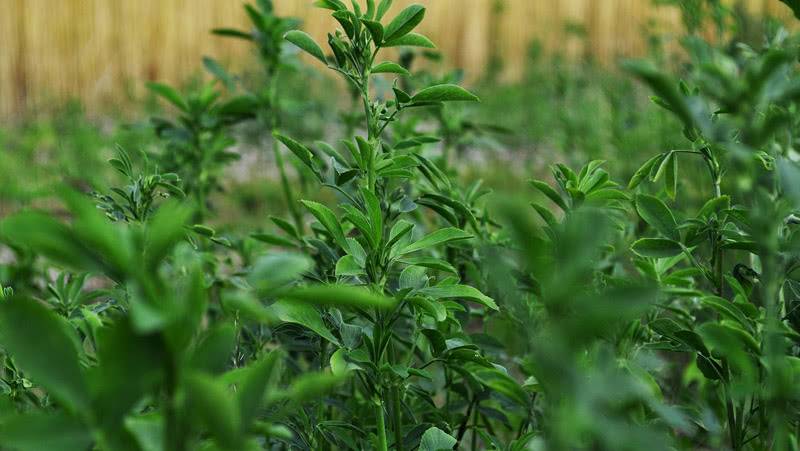

Alfalfa
The use of several types of green manure at the same time significantly increases efficiency.
For cucumbers
Sown before the start of gardening or harvesting, the following plants are used:
- mustard white;
- phacelia;
- oil radish.
They not only perform the function of fertilization, but are also used to prevent pest damage.
For raspberries
Siderates are sown at the end of the summer season. The most common:
- lupine blue;
- oats;
- peas;
- mustard.
Sown in July - August, they build up a sufficient amount of greenery by the end of autumn.
Beetroot
Root crops grow well after flower crops. It is not recommended to use cereals.
Under the grapes
For vineyards, it is effective to use the greening method on clay, heavy soils. Cultivation is practiced between rows, less often - sowing in continuous rows over the entire area of the vineyard.
Sideration is effective using rapeseed, mustard, winter rye. Legumes are sown in late summer, and winter crops in August - September.
Under cabbage
For green manure under cabbage, seeds are sown in spring and autumn using seeds:
- annual lupine;
- beans;
- clover;
- peas;
- chickpea;
- wiki;
- sweet clover;
- alfalfa.
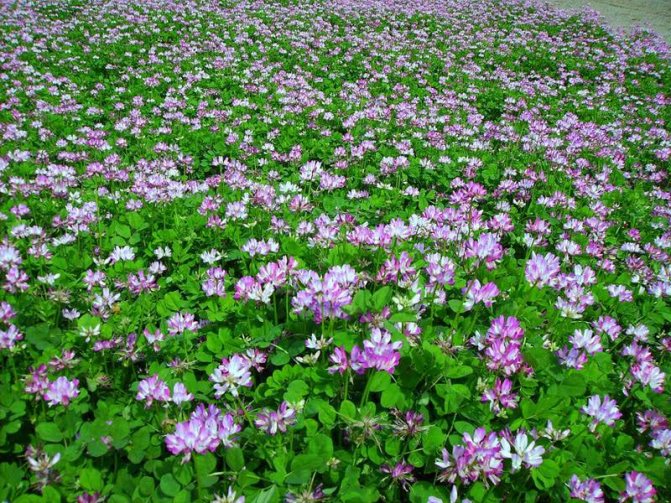

Vika
It should be borne in mind that the stalks of cereals decompose slowly and the cabbage does not have time to grow foliage. It is recommended to combine siderata with each other.
Cabbage greatly depletes the land, so green manure should be carried out all year round.
For zucchini
Almost any annuals are suitable for unpretentious zucchini:
- mustard;
- oats;
- Vika;
- peas;
- lupine.
Any sowing time, the entire growing season, from spring to late autumn.
For dill
Any annual plants can be the predecessors of dill. And the dill itself looks like a green manure, thanks to its fast growth rate, abundant greenery and unpretentiousness.
Strawberry
The site is prepared in advance, at least six months - a year in advance. Summer planting of green manure is recommended if the berry bushes will be planted in the fall.
The best green manure plants in the spring:
- buckwheat;
- Vika;
- calendula;
- mustard;
- dill;
- rape;
- marigold;
- spinach;
- radish;
- lupine.
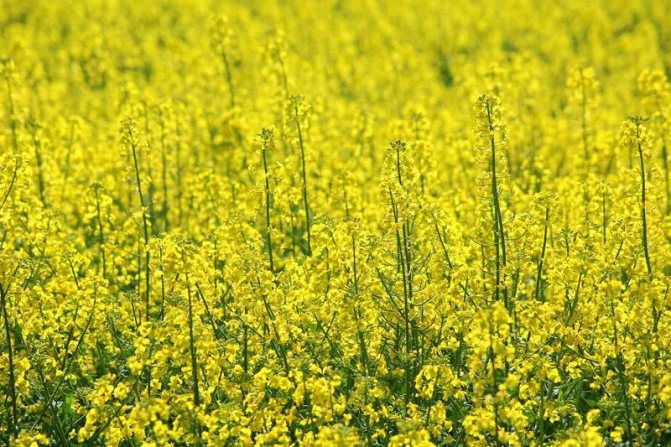

Rape
Aboveground greens are cut off 12-14 days after planting. For planting in the spring, cold-resistant plants are required so that the green mass can grow before the cold weather. After picking the berries, sowing of rye, mustard, oats, phacelia and rape is allowed.
For garden strawberries
An excellent option for garden strawberries is flowers:
- marigold;
- tulips;
- daffodils;
- marigold.
Cereals and herbs are suitable: parsley, dill, celery, salad.
Legume siderates
Legumes make the soil looser, their main differences:
- supply of nitrogen and phosphorus;
- providing with humus;
- decrease in acidity.
Siderata from leguminous plants are cold-resistant, but moisture-loving.
By their nutritional properties, green manures are similar to manure: they improve the soil with organic matter and humus.
Weed siderata
The green manure method for weed control is justified and proven by many years of tests. Weed control is evident after the first emergence - the root system acts as a barrier.
After a sufficient amount of greens has been collected, it is closed up for decay.
Green manure for soil
Improving the soil with green manure can significantly improve its composition. This common method does not require large expenditures, increases the yield and quality of fruit and vegetable products.
It is most effective to use a mixture of green manure. Crops are sown in spring, summer and autumn. Compatibility with vegetable crops, characteristic features are taken into account:
- frost resistance;
- drought resistance;
- the amount of aboveground green part;
- ripening and harvesting terms.
For acidic soil, the following plants are most suitable:
- lupine;
- rye;
- mustard white;
- sweet clover;
- phacelia;
- alfalfa.
Before using one of the green manure crops, it should be borne in mind that each of them not only lowers the acidity, but can affect the growth and condition of vegetables.
Digging or mulching - what to choose?
After several weeks from the moment the seeds are embedded in the soil, the summer resident can see the first shoots of green manure. They will gain vegetative mass and form the root system within 30-40 days, depending on the variety.
Before embedding green manures in the soil, the farmer must make sure that they have developed enough - they have formed dense tops and formed branched root shoots.
After the siderates in a greenhouse, in a field or in a private garden plot have grown, you can begin to close up their vegetative mass. The farmer can accomplish this task in two ways - by mulching with green manure or by choosing to dig up the land along with green shoots of organic fertilizers. There is a lot of disagreement about whether it is necessary to plow green manure in autumn and spring. However, the farmer can independently decide what is better for him - traditional arable land or innovative no-till farming. Both the first and the second method have their advantages and disadvantages, so before making a final decision, the agrarian should compare them.
If he chooses the option of digging, then he will need a shovel or mechanized agricultural machinery - a cultivator or a mini-tractor with a special bracket. The filling is done at a shallow depth of 7-10 centimeters. This approach will deliver the nutrient mass of green manure to the lower layers of the soil, as well as improve the structure of the soil.
If a farmer chooses no-till farming and is going to prepare valuable mulch from the greens of the ground cover, he will be concerned about another question - is it necessary to mow the green manure in autumn and spring? Experienced summer residents recommend mowing the tops, as this will quickly get a large amount of green fertilizers. You can use an ordinary scythe or a special trimmer to mow the tops. At the same time, the main thing is not to plan the mowing of green manure for the period of their flowering, since such a step will lead to uncontrolled self-seeding. After mowing, spread the cut greens over the field and leave to rot. After several weeks, ordinary tops will turn into valuable fertilizers and saturate the soil with the necessary organic elements. When making mulch from green manure, a summer resident may need a shredder. It helps to prepare a large amount of fertilizer from the cut green mass of green manure in a short time. You can also grind green manure with ordinary garden shears.
The benefits of green manure
The use of green manure is a common agricultural technique, it is chosen for various reasons:
- the formation of a compost layer;
- moisturizing;
- loosening;
- enrichment with nitrogen, starch, sugar and proteins;
- hindering the growth of weeds;
- mulching;
- restoration of land after erosion;
- prevention of diseases and pests of horticultural and horticultural crops;
- improving the quality of fruits;
- prevention of soil weathering.
Reference! Many types of green manure are excellent honey plants.
It is a versatile feed for beneficial bacteria and earthworms to help improve soil structure. Do you need siderates? Proponents of natural farming argue that they are necessary, but it is important to consider the timing of crops and the effectiveness of their use, depending on this.
The grass mowed produces excellent compost. Traditional technology is practiced:
- plant residues are mixed with peat, forest litter, chopped straw;
- layers alternate, adding wood ash and fomforite flour;
- spill as needed.
Compost heaps are formed up to a height of 1.5 meters. After six months, such compost is ready for use.
Related videos:
Lupine annual
Lupine is able not only to enrich the earth with nitrogen, but also to process hard-to-reach soil elements. This culture is suitable for the development of poor sandy and podzolic soils with high acidity. As a green manure, lupine is considered the best predecessor for garden strawberries (strawberries).
Lupine accumulates 200 kg of nitrogen per hectare
Not only does this plant bloom very beautifully and is able to decorate any flower bed, lupine also perfectly accumulates nitrogen in the soil. This green manure is planted on poor soils, in particular, sandy. Lupine is usually sown in early spring and is an excellent precursor for strawberries and other plants that need nitrogen. But you can sow lupins in mid-August in the area from which potatoes or cabbage have already been removed.
We suggest you familiarize yourself with: The best types and styles of bonsai
Siderata of the family of cereals
Oats
Oats are a cold-resistant plant. Enriches the soil with organic matter and potassium. Suppresses the growth of weeds. It loosens and structures the soil well with a massive fibrous root system. Root excretions of oats have a detrimental effect on a number of soil pathogens.
Usually oats are used in a mixture with vetch and (or) peas, lupine. Mixed crops of oats and vetch contribute to an increase in the yield of both crops by 20-30% compared to their separate crops. Oats and lupines also have a positive effect on each other.
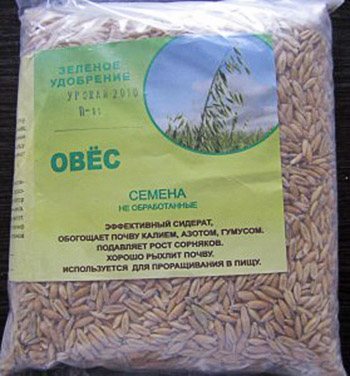

Oats are sown in early spring, at a seeding rate of 10-15 g / m2. Mowed before flowering, usually at a plant height of 18-20 cm. Over the summer, in one place, you can make 2-3 mows of oats without sowing. It can also be sown in the second half of summer after harvesting early vegetable crops. It grows all autumn, in spite of frosts, covers the soil with a green brush, then it will freeze and will contribute to snow retention and cover the ground with itself and with snow. In the spring, the bed does not need to be loosened, it is covered with oat mulch, the mulch decomposes, enriching the earth, nourishing and protecting earthworms.
Wheat
Another cereal used as green manure. Wheat is grown for green fertilization with subsequent embedding in the soil. Also use:
- for composting;
- liquid fertilizer for dressing;
- mulching.
Wheat improves soil structure. Sow it in spring or summer at a seeding rate of 9-10 g / m2. Mowed or buried in the soil in summer or autumn.
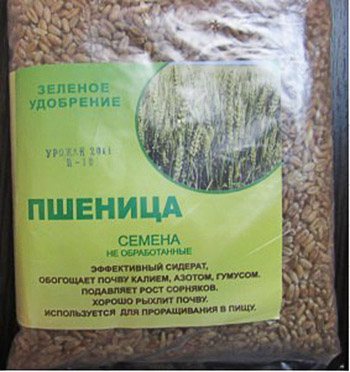

Winter rye
Winter rye is a green manure that is most suitable for winter sowing. Sown at the rate of 9-10 g / m2. Close it up in the soil in the spring before the lignification of the stems. Young and tender plants decompose quickly and enrich the soil with organic matter, nitrogen and potassium. Coarser plants decompose more slowly and release nitrogen more slowly. They are also used in a mixture with vetch.
Rye is a very good plant for improving the physical properties of the soil, but its disadvantage is a strong drying effect on the soil. Therefore, its sowing in the aisles of fruit trees can be used only in conditions of sufficient moisture, otherwise the fruit yield will be greatly reduced.
Rye has been observed to kill root nematodes.
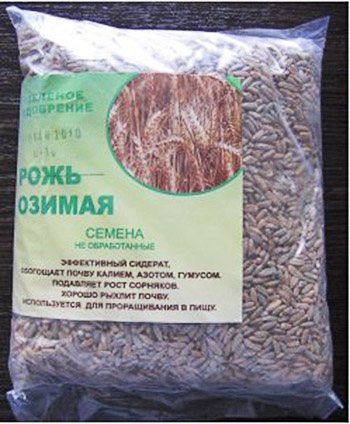

You should also pay attention to the factor that many plants do not like rye.It suppresses their growth and development, therefore, planted in one place for two years in a row, rye helps to get rid of many weeds, including wheatgrass.
When to bury (plow in) green manure
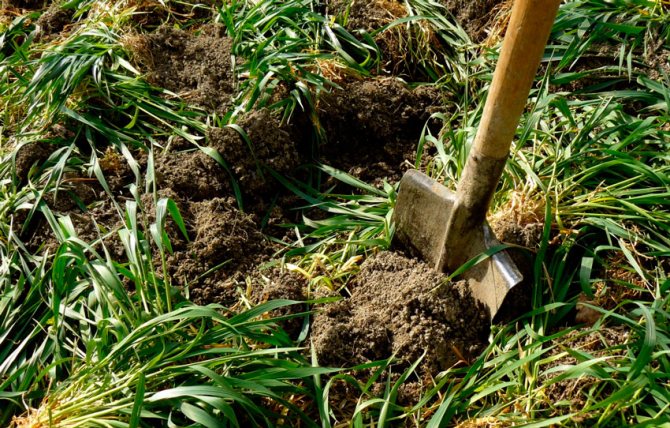

Experts say that plowing "green fertilizer" allows you to improve the structure of the soil much better, as well as to avoid compaction of the arable layer. Another siderates contribute to the improvement of water permeability and moisture capacity. All this contributes to the activation of microbiological processes. It is recommended to bury or plow the "green fertilizer" 7-14 days before the main crop is planted. It should not be forgotten that the green manure must be mowed or cut before the budding period begins. But those who applied this method in practice believe that as a result of digging or plowing green manure, microorganisms that plants need disappear, and this also leads to a violation of the structure of the soil. They advise to cut off the "green fertilizer" with a flat cutter, going 5 centimeters deep into the soil, and the cut shoots must be evenly placed over the surface of the garden bed and mulched from above to avoid drying out. The cut tops of the green manure over time become compost, with the release of a large amount of nitrogen. The root system, which remains in the soil, gradually decomposes thanks to microorganisms and earthworms, resulting in the formation of humus. It is especially not recommended to plow winter green manures, since in this case about 80 percent of green manure impact is lost. After cutting or beveling the "green fertilizer", it is laid out on the surface of the soil in winter. In spring, the snow will melt, and you will not see these plants on the site, but the soil will be very loose.
Mustard white
In addition to enriching the soil and suppressing weed growth, mustard also protects the area from wireworms. It has a powerful root system with a length of more than 1 m, and after cutting, the roots rot in 1.5-2 weeks, forming a network of channels for the movement of air and moisture to a great depth. Mustard is sown in autumn after harvest or in spring 1 month before planting potatoes.
White grits are capable of releasing sparingly soluble phosphates
This green manure is very important for crop rotation, the roots of white mustard are capable of releasing organic acids, which begin to release poorly soluble phosphates in the soil. As a result, the potassium supply in the soil is replenished, and the plants gain access to useful elements that were previously difficult to extract. In addition, white mustard suppresses all weeds and drives wireworms from the beds.
Clover
Another plant that enriches the soil with nitrogen. This crop is suitable for areas with good moisture, it is frost-hardy and is a good honey plant. Clover can also be sown in the aisles of horticultural crops: there it grows without overseeding for 2-3 years.
Sowing clover on the site is equivalent to applying 300-400 kg of manure per one hundred square meters
Perennial green manure with many useful properties. In the garden, it can be planted between trees, in the shade, and in the beds - in those areas where you do not plan to grow anything for two years to give the soil a rest. Clover saturates the soil with nitrogen and strengthens it. This is a melliferous plant, hay is actively used for livestock feed.
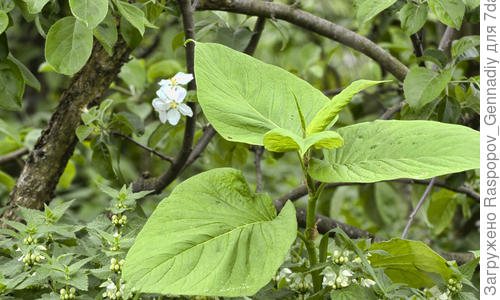

Experts recommend mowing the clover before the buds bloom, which are very nitrogen-rich. You can cut this perennial green manure in the spring, in May, when the bushes that are not afraid of frost will grow and begin to bud. Already two weeks after embedding the green mass of clover in the ground, vegetable seedlings can be planted in this area.
Donnik
Like other legumes, sweet clover accumulates nitrogen in the soil. It also inhibits nematodes and improves soil structure.
The Ukrainian name for sweet clover is burkun.Even among the people it is called vargun and borkon
This plant is distinguished by significant winter hardiness and drought resistance. Suitable for sandy and clay soils, but does not like acidic and very wet soils.
The Ukrainian name for sweet clover is burkun. Even among the people it is called vargun and borkon
Phacelia annual
Thanks to this green manure, the soil is saturated with organic matter and loosened. Phacelia is suitable for almost any soil and climatic conditions. It can be sown several times per season. Thus, you will accumulate a large mass of organic matter and can do without additional fertilization.
Thanks to this green manure, the soil is saturated with organic matter and loosened. Phacelia is suitable for almost any soil and climatic conditions. It can be sown several times per season. Thus, you will accumulate a large mass of organic matter and can do without additional fertilization.
We suggest you familiarize yourself with: Horse manure as fertilizer - benefits and how to apply
Phacelia is recognized as a universal green manure. It has no related crop plants, so it can be grown before and after any vegetables.
Remarkably loosens the soil due to the developed root system, increasing the air permeability of the soil. Phacelia grows on any soil, does not require a lot of light, it is not afraid of cold weather. This green manure is considered an excellent precursor for most vegetables. An important property of phacelia is the ability to attract beneficial insects with its nectar, which will destroy moths, apple flower beetles, and leafworms on the site. In addition, the proximity to phacelia destroys nematodes, and locusts and wireworms will leave this area.
Types of green manure
There are a great many green manure plants. These are, as a rule, annuals, since perennials are more difficult to process. What kind of crops do experienced gardeners usually use?
Table. Siderata by families.
| Family | Cultures |
Legumes | Vetch, soybeans, peas, lentils, lupine, mouse peas, alfalfa. These types of plants have special nodules on the roots - clusters or, rather, colonies of bacteria that help to accumulate nitrogen. They are called "nitrogen fixers". If you grow three crops of legumes, then we can say with confidence that as much organic matter got into the soil as the full dose of manure gives. These plants do an excellent job with frost, grow quickly, and have a good effect on the soil. |
Cruciferous | Radish, rapeseed, mustard, rape. They are sown in August or July and left to rot in the soil along with the tops and fruits. True, only those who have a lot of extra seeds decide to leave them. The only drawback of these plants is that they cannot be used where other Cruciferous plants will be sown. |
Cereals | Oats, rye, barley, wheat. These crops are hardy in relation to weather changes, easy to work, and easily sprout. Sown in the fall. |
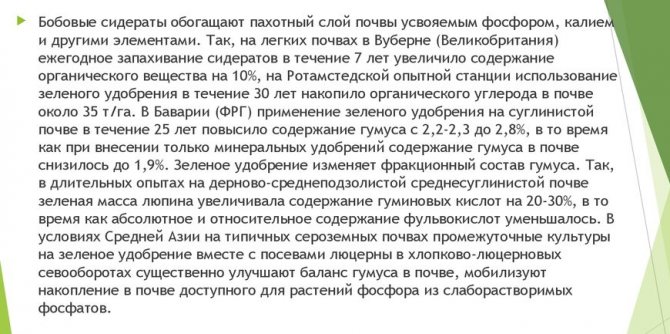

Legume siderates
On a note! Sometimes weeds can also be green manure. For example, wood lice or wood lice are small green grass, the "scourge" of many summer residents. But in fact, it is harmless and is an excellent siderat.
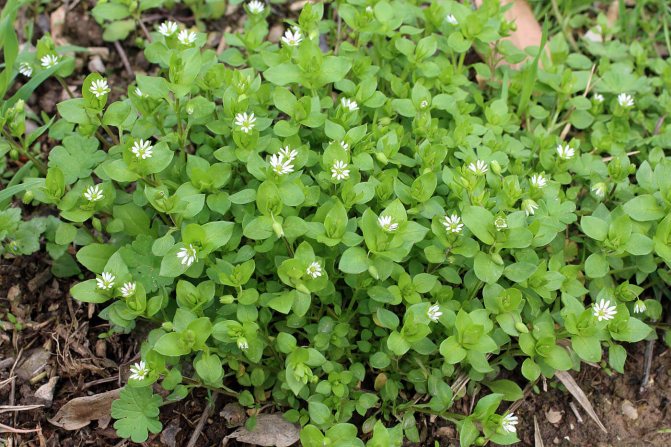

Woodlice is also an excellent green manure.
Let's take a closer look at some of the siderates. This will allow you to make a choice in favor of a particular plant and decide which one will grow in your country house and improve the soil on it.
Radish, belonging to the Cruciferous family, is unpretentious and grows easily on heavy clay soils. This annual has a powerful root system that can penetrate to a depth of 2 meters! Easily extracts nutrients from the deep layers of the soil, transforms them into those that can be assimilated by other plants. Radish is also a phytosanitary - it protects plants from scab and other diseases. Usually sown after harvesting early vegetables. The tops often remain on the surface of the soil for the whole winter and are embedded in it only in spring.
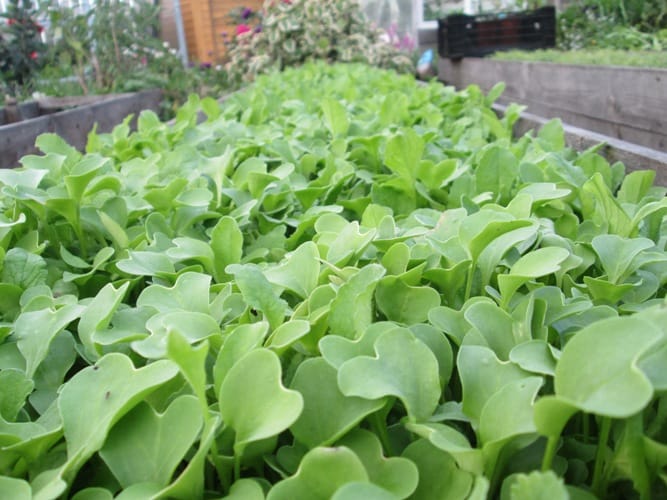

Oil radish as siderat
Buckwheat (Buckwheat family) is a plant suitable for saturating the soil with phosphorus, organic matter, and potassium. Usually grown on heavy soils. She has a well-developed strong root system that has a beneficial effect on the structure of the soil. It is used during spring or summer planting of green manure.
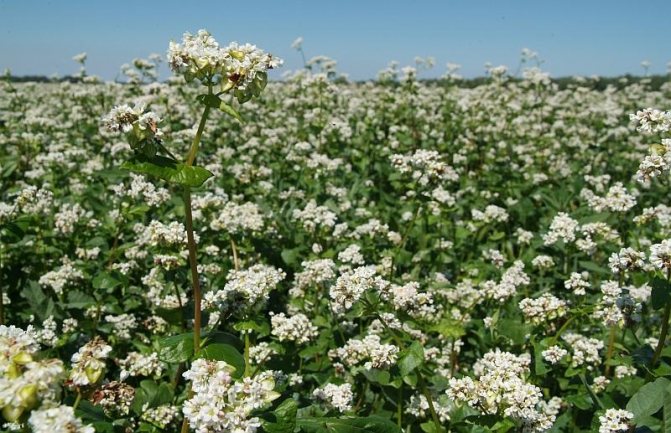

Buckwheat
White mustard is an annual of the Cruciferous family. Perhaps the most popular green manure, with which every fan of natural fertilizers is familiar. Its properties are very similar to radish, but it is more capricious in relation to growing conditions, while it ripens faster, therefore it is planted 2 weeks later than radish. Mustard is rich in potassium, phosphorus, and there is a lot of nitrogen in it. The root system is able to penetrate into the soil to a depth of 3 m, due to which the soil is well drained and becomes loose.
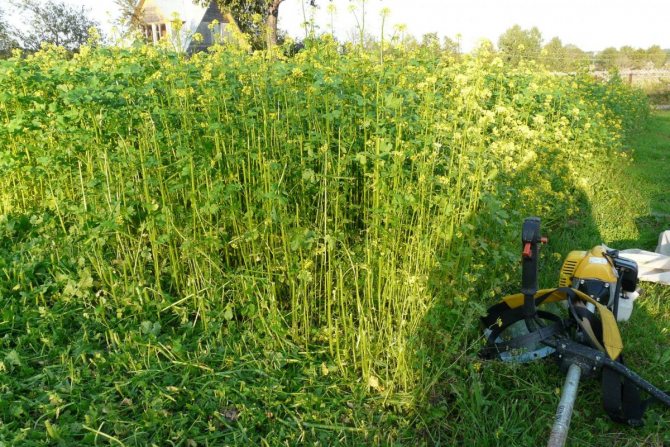

Mustard white as siderat
Phacelia belongs to the Aquifolia family and can be planted in front of any garden crops. It is sown both in autumn and summer after the first harvest of vegetables. Phacelia has a positive effect on the acidity of the soil - it makes the acidic soil neutral. Thanks to this feature, it drives out some types of weeds from the site. The stems of this culture can be used for mulching the soil, obtaining compost. Phacelia are hated by nematodes, wireworms - they disappear from the place where this culture lives. It is also able to prevent some dangerous diseases, so it can be planted between the rows of main plants.
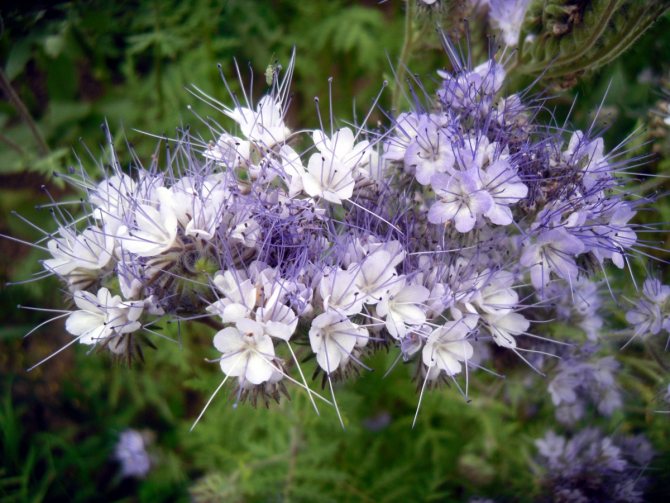

Phacelia
On a note! Phacelia blooms with very fragrant flowers and will easily attract pollinating insects - bumblebees and bees to the country.
Siderata can be combined when grown: for example, a good duet is obtained from vetch and oats. Together, they will ensure that almost all the nutrients necessary for plants are supplied to the soil.
Greenhouse siderata
In a greenhouse, to improve the condition of the soil, the soil is often simply replaced completely. However, sometimes it is enough to use green manure for only a few years so that you no longer have to do such laborious work.
Choosing plants for different types of soil
Which green manures are the best, if the plants are selected taking into account the fertility and types of soil, consider in the table.
| Type of soil substrate | Suitable green manure |
| Clayey |
|
| Loam |
|
| Peat |
|
| Sandy |
|
| Sandy locks |
|
Beans and beans can be planted on podzolic substrates.
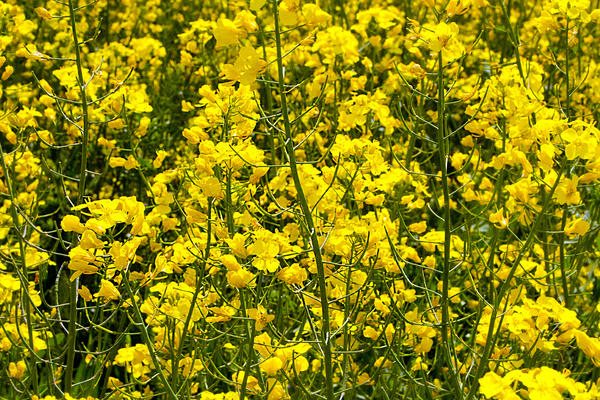

Universal green manure
These are crops that are effectively cultivated on different types of land. The list includes:
- rape;
- sunflower;
- mustard.
Spring rape
The culture forms a powerful root system with a depth of more than 1 m, due to which it loosens dense soils well. In addition, rapeseed has fungicidal properties, while enriching the soil with organic matter, phosphorus and sulfur.
Rapeseed is not as good a nitrogen supplier as legumes. However, it perfectly prevents the leaching of this chemical element from the soil.
Rapeseed is not as good a nitrogen supplier as legumes. However, it perfectly prevents the leaching of this chemical element from the soil.
This is a very useful plant in itself, a honey plant, from its seeds they even learned how to make biodiesel fuel. But as a green manure, rapeseed is primarily known for saturating the soil with sulfur and phosphorus, protecting the beds from diseases and pests, and inhibiting weeds. Rape is an excellent precursor for tomatoes, peppers and eggplants. You can plant it in August, in winter, for this, the winter variety is used, but there is also a spring one.
Pros and cons of landing
You can evaluate the benefits of green manure crops by their useful properties:
- the use of nursery plants for soil healing is a natural process, which indicates safety;
- restoration of fertility and improvement of the structure occurs in just a few months (before the decomposition of the green mass);
- preventing the formation of erosion;
- the form of fertilization is acceptable for microorganisms living in the soil;
- green manure suppress the growth of weeds;
- deeply penetrating root system of crops makes the soil loose, thereby increasing its air and moisture permeability;
- grown green manures are simply dug up on the site, there is no need to collect them, carry them, distribute them over the garden;
- cultivating the land with green fertilizers cleans up harmful bacteria, spores, larvae of pests and the parasites themselves.
In the discussions of gardeners, there are also negative reviews about the use of green manure plants. For example, when planting a sweet clover, the germination of shoots is observed for several years. This is due to the fact that this culture is perennial, so it will not be possible to remove the grass in one year. Someone considers this to be harmful and prefers annual herbs.
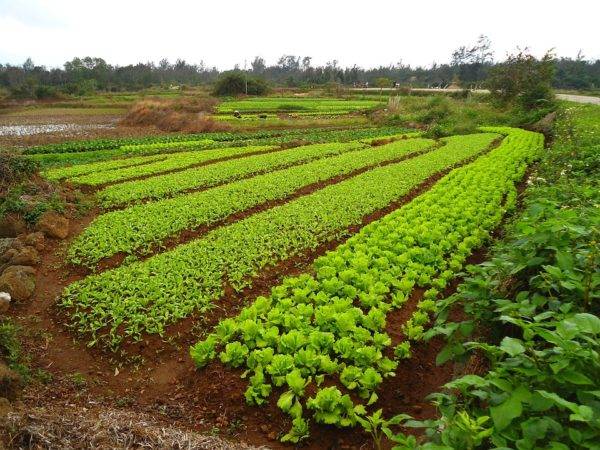

Correctly planted green manure prevents soil erosion
In this case, there is only one recommendation - before sowing, you need to familiarize yourself with the characteristics of the green manure, and only then make a decision on its use.
The disadvantages include the exact observance of the terms of harvesting green mass.
If you hold out until the seeds are formed, you will not be able to get high-quality fertilizer.... The stems are stiff at this stage. Therefore, it is important not to miss the beginning of flowering, when the plant is filled with the maximum amount of micronutrients and retains the delicate structure of stems and foliage.
Vegetable peas
This culture enriches the soil with nitrogen, phosphorus, organic matter. It is used not only for individual plantings, but also used as a ground cover plant under trees.
Nodule-fixing bacteria settle on the roots of this plant, which accumulate additional nitrogen.
This plant is tasty and useful in itself, but as a green manure it has a number of useful properties. The main thing is that peas help to accumulate phosphorus and nitrogen in the soil, this will increase the productivity of plants planted after it. Peas ripen quickly, which allows them to be used to improve soil composition between planting of other crops.
This green manure drains the soil, improves moisture and air permeability. In addition, in the area with peas, there are good conditions for the activity of worms and other beneficial microorganisms, which reduce the incidence of diseases and help to get a rich harvest. If the peas are planted tightly, they will also suppress all weeds.
Sowing alfalfa
The culture has an extremely powerful root system (up to 3 m deep), enriches the soil with nitrogen, organic matter, phosphorus. Alfalfa produces a large green mass. For this reason, it is often used as a forage plant.
Alfalfa is also an excellent melliferous plant and is also used in medicine as a sedative.
Alfalfa is also an excellent melliferous plant and is also used in medicine as a sedative.
A very valuable forage crop that has been growing in one place for several years. The roots of alfalfa can reach three meters, so they loosen the ground perfectly. In addition, this green manure raises the level of phosphorus and nitrogen in the soil. Alfalfa repels nematodes, gets rid of weeds. As a green fertilizer, alfalfa is especially suitable for potatoes, tomatoes, peppers, eggplants, as well as berries, including gooseberries, cherries, wild strawberries and strawberries.
We suggest you familiarize yourself with: The best varieties of squash
When and how to clean?
Many novice gardeners dig up siderates. And they make a big mistake. This cannot be done. Digging reduces efforts to rehabilitate the soil to zero.After all, it is the rotting of the roots that improves the physical properties of the earth.
How and how to harvest green fertilizers? Siderata should be cut with a cultivator or flat cutter. Pruning is done during budding or after flowering. Overgrown plants rot take longer, give little nitrogen and sometimes turn sour.
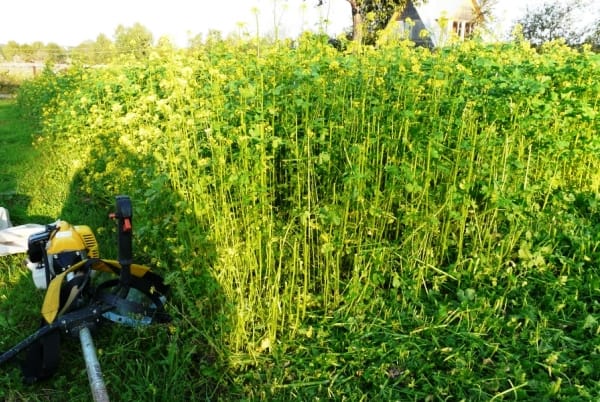

The tool must be well sharpened. Pruned at a distance of 2-3 cm from the surface. The roots must remain in the soil. Then the site is treated with a solution of "East", "Baikal" or "Shining". The listed EM preparations contribute to the faster decomposition of plant residues.
Cut tops can be used for mulching, or can be composted or added to liquid root dressing.
Siderata - what is it?
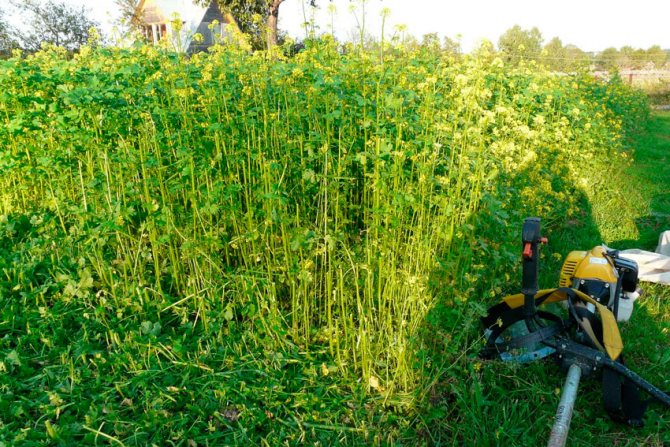

Green manure is a green fertilizer that is grown specifically to normalize the condition of the soil. After the growing season, such plants saturate the soil with nitrogen, as well as nutrients and help in the fight against weeds. From the Latin language, the word "sidera" is translated as "a star receiving power from the sky." Sideration plays a very important role in organic farming.
Siderites include plants that are fast growing. After the green manure is mowed, they are either left on the surface of the soil or embedded in it, and the roots remaining in the soil after rotting will saturate the soil and subsoil with nutrients. Such plants are able to drown out weeds with their green mass and also protect the soil surface from the scorching rays of the sun. And also a rather powerful root system of such plants contributes to the fact that the weed cannot eat normally. Also, the roots make the soil looser, and when they rot, they improve its ability to pass and absorb water, and also have a positive effect on aeration.
So, often as siderates grow leguminous plants that are annuals (less often perennials are used), which have a very powerful aboveground part and phytosanitary properties. And also the best options for the garden will be cereals, characterized by their rapid growth and cold resistance. As well as early green manures, plants belonging to the Asteraceae or Cruciferous family are very popular.
The main mistakes of gardeners when greening a plot
The main requirement is the absence of conflict between the main culture for which the site is being prepared and companions. You can not sow green manures for the garden after crops that belong to the same family. Most often these are cruciferous and all types of cabbage, radishes, turnips, horseradish, rutabagas. Plants will surely get sick and there will be no harvest
The second mistake is the time of sowing green manure. You need to sow until the first weeds appear. If green manure plants emerge first, the weeds will not be able to break through their dense root veil.
Plants prefer one type of soil. When choosing green manure crops for your plots, you need to take into account their needs, or sow ones that are universal.
Green fertilizer is comparable to manure in its chemical composition, therefore it replaces it. But the norms should be observed so that organic matter does not sour in the soil.
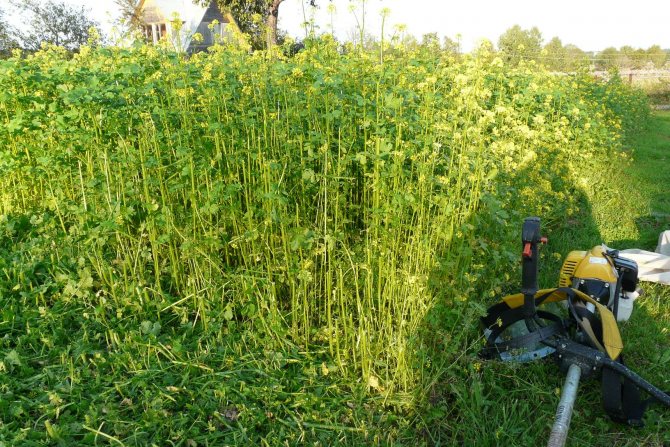

The biggest mistake is to rely entirely on sideration. This is wrong because these plants also need nutrients. They need to be fertilized with mineral mixtures, which later turn into organic matter and add humus.
If the crops are not fed, they will take away the remnants of nutrition from the soil, while the microorganisms will have nothing to feed on and their number will sharply decrease. When green fertilizer is embedded in the soil, there will be no one to decompose it, the substance will acidify, and pests and fungi will feel great in such an environment.


